THE ART OF THE ESPALIER TO THE MILKY SHADE OF ‘VERSAILLES GREEN’
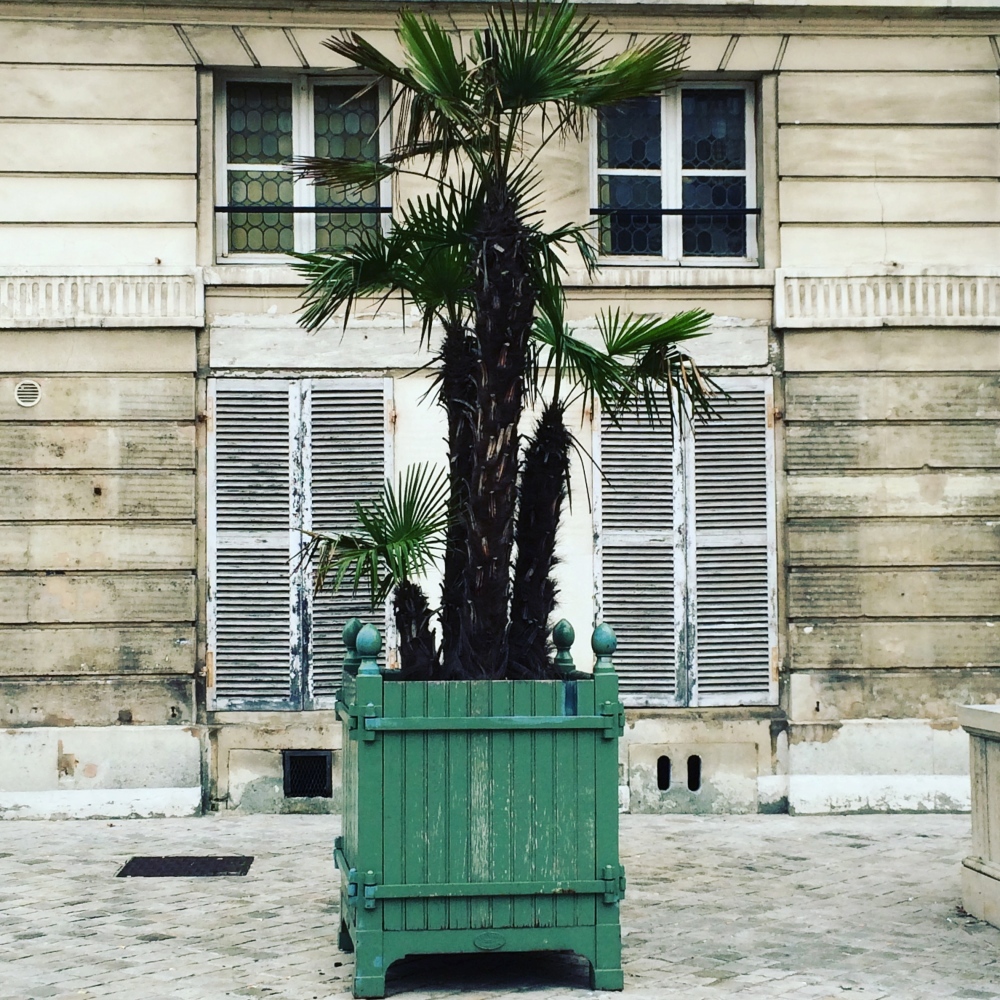
‘Versailles’ planter with palm, Versailles green, Versailles
As I sit down to write my November post – the starting point, a family half term trip to Paris – I am filled with an aching sadness that our memories of those cheerful and inspiring three days have been shaken upside down by the horrifying terrorist shootings which took place a week ago today.
But I am keen to take you back to our trip to Paris, one of many visits over my lifetime (indeed I spent a few months living in Paris as an Art History student in my Gap year) to rekindle the deep fondness I have for the city and for French life beyond the city, to show my support and to tell you about my commitment to be back there again in the spring.
*********
Still I worry a little about starting my account with our first stop on our first day in Paris: a return visit to the ultimate sock shop, Mes Chaussettes Rouges .
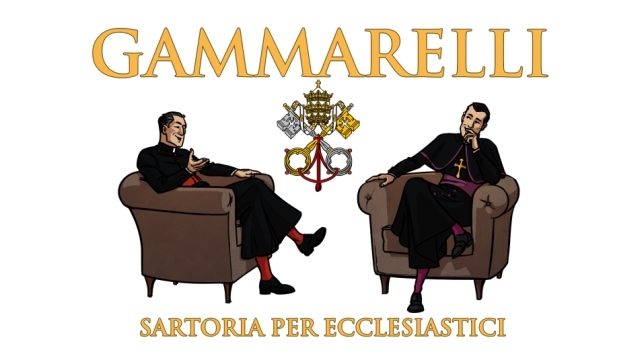
Cheery ad for Gammarelli ecclesiastical finery sets the tone at Mes Chaussettes Rouges
Mes Chaussettes Rouges is a small, delightfully eccentric shop which sells such wonders as long red socks by the Italian tailor, Gammarelli – the Pope wears the white versions – and long green socks in ‘vert académie’ by the French brand, Mazarin, the green knee-highs worn by members of the Académie Française. Fundamentally, of course, these are excellent quality, traditional socks, which have been introduced to a wider market. And if you have married a certain kind of husband you will make him pretty happy if you spend a few minutes in this immaculate rainbow of a shop helping select some hosiery of exactly the right weight, length and shade of soft blue.
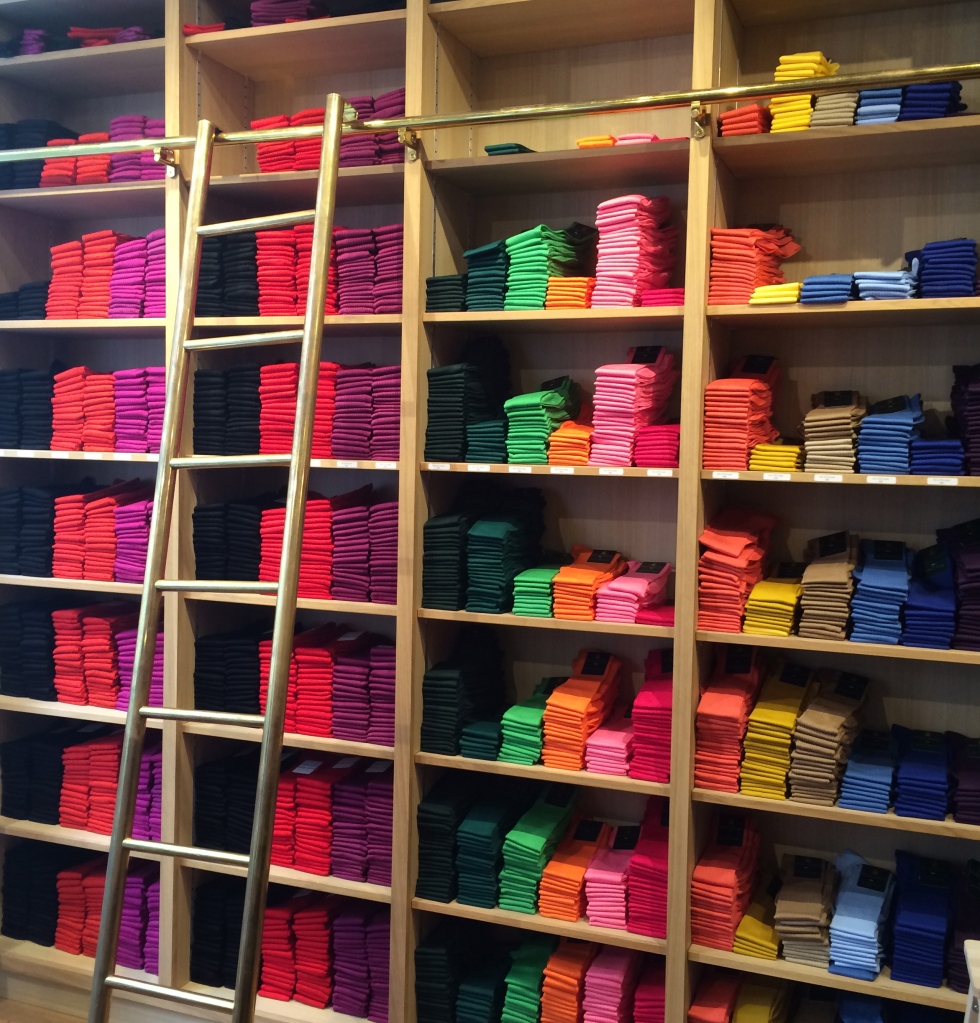
The finest gentlemen’s socks on display at Mes Chaussettes Rouges
Some homemade pasta and a glass of wine in the cosy Italian deli on the other side of the rue César Franck and then an afternoon only gently frogmarching our sixteen year old son to the Army Museum at Les Invalides. We had discovered this excellent combination of socks and spaghetti only six months earlier when we visited in the spring with our older boys on our way to the France v. Wales rugby match at the Stade de France – a post exam celebratory treat. How heavily the name ‘Stade de France’ sits in my stomach now after the Friday 13th shootings.
The Musée de l’Armée is an enormous, graceful, museum of pale Parisian stone with exhaustive collections. We are on a mission to discover more about Napoleon. We visit Napoleon’s extraordinary oversize marble tomb, are dazzled by Ingres’ mesmerising, high-gloss portrait of Napoleon I on his Imperial Throne – we are moved by his battered black hat (famously and symbolically turned on its side and worn the way a commoner would wear a hat) and admire cases of beautifully crafted flags and ceremonial clothing decorated with the most exquisite embroidery.
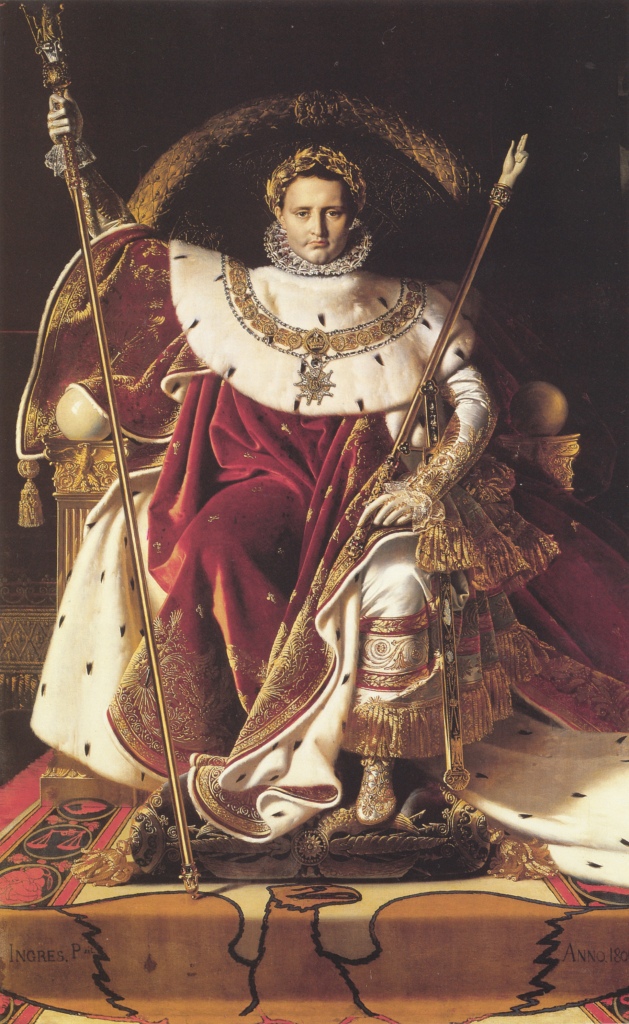
‘Napoleon I on his Imperial Throne’, Ingres, 1806
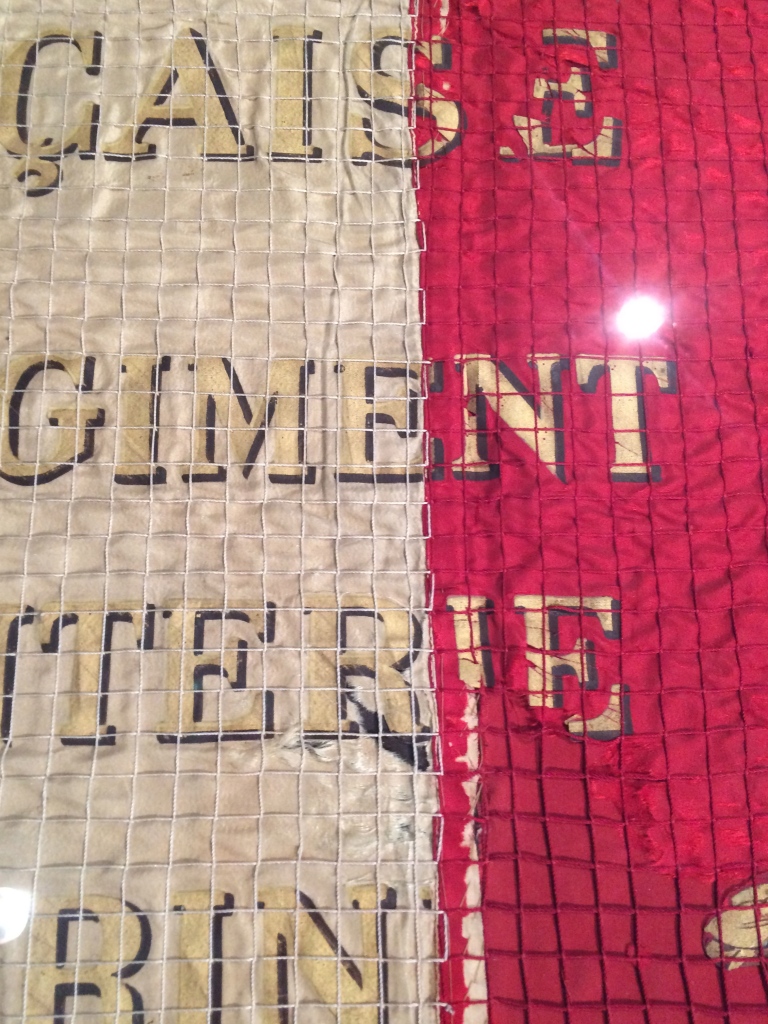
Fragment of military Tricolor in quilted silk, Musée de l’Armée, Les Invalides, Paris
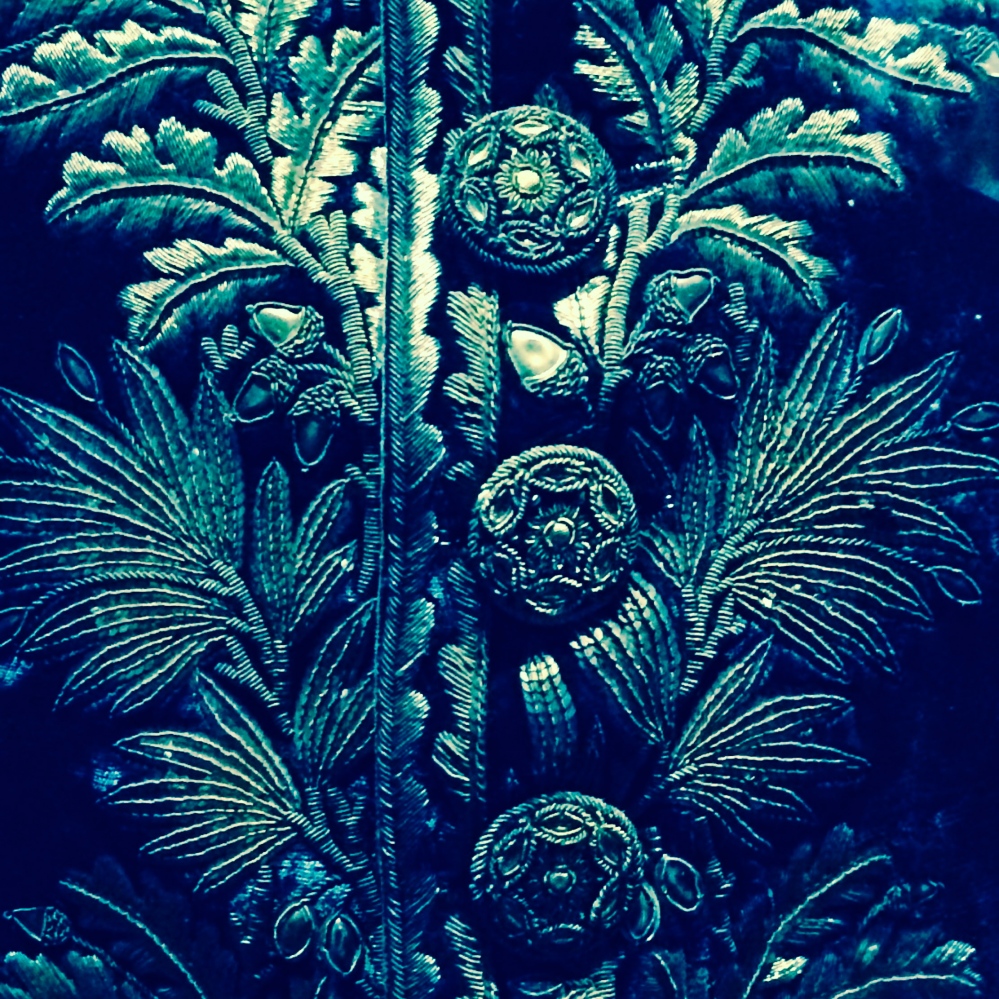 Detail of oak leaf embroidery in gold thread, late 18th Century French uniform
Detail of oak leaf embroidery in gold thread, late 18th Century French uniform
I have never even walked close to the Eiffel Tower before and am rather amazed to understand that I have agreed to a twilight visit .
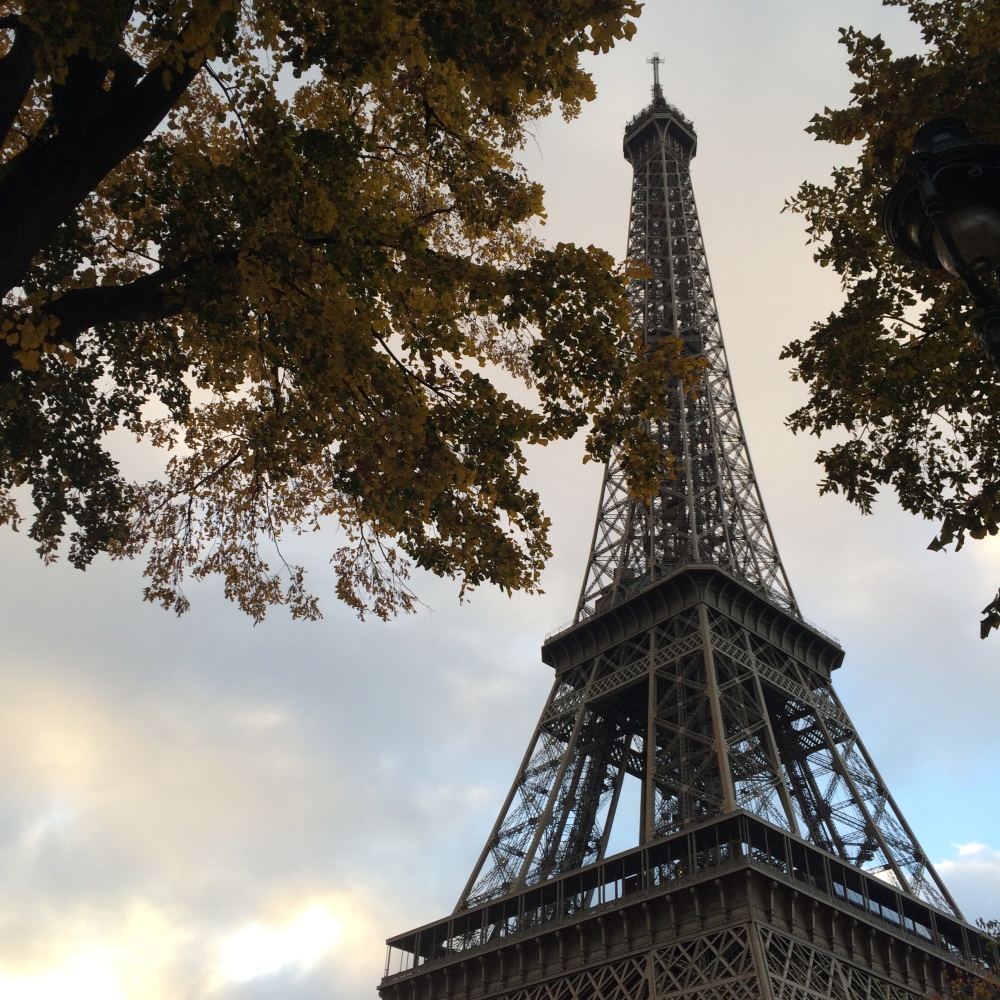 Eiffel Tower, late October, late afternoon
Eiffel Tower, late October, late afternoon
But the tower looks elegant and a satisfyingly subtle shade of brown against the autumn leaves of the surrounding trees. I learn riveting facts about the painting of the Eiffel Tower. Originally, in 1887-8, it was painted a rich ‘Venetian Red’, in 1899 the tower was painted in shaded tones from yellow-orange at the base to light yellow at the top, in 1954-61 it was painted a ‘brownish red’ and since 1968 the exclusive ‘Eiffel Tower Brown’ paint has been used – a sort of milk chocolate grey-brown, a colour chosen to blend in with the Paris cityscape. Cunningly it is still painted in three different tones, darker at the bottom and lighter at the top to accentuate its height.
I start to smile when we get to the top. I love spongy, painterly quality of these iPhone images capturing the glowing autumn colour and rhythmic layout of the trees along a network of pale Parisian paths.
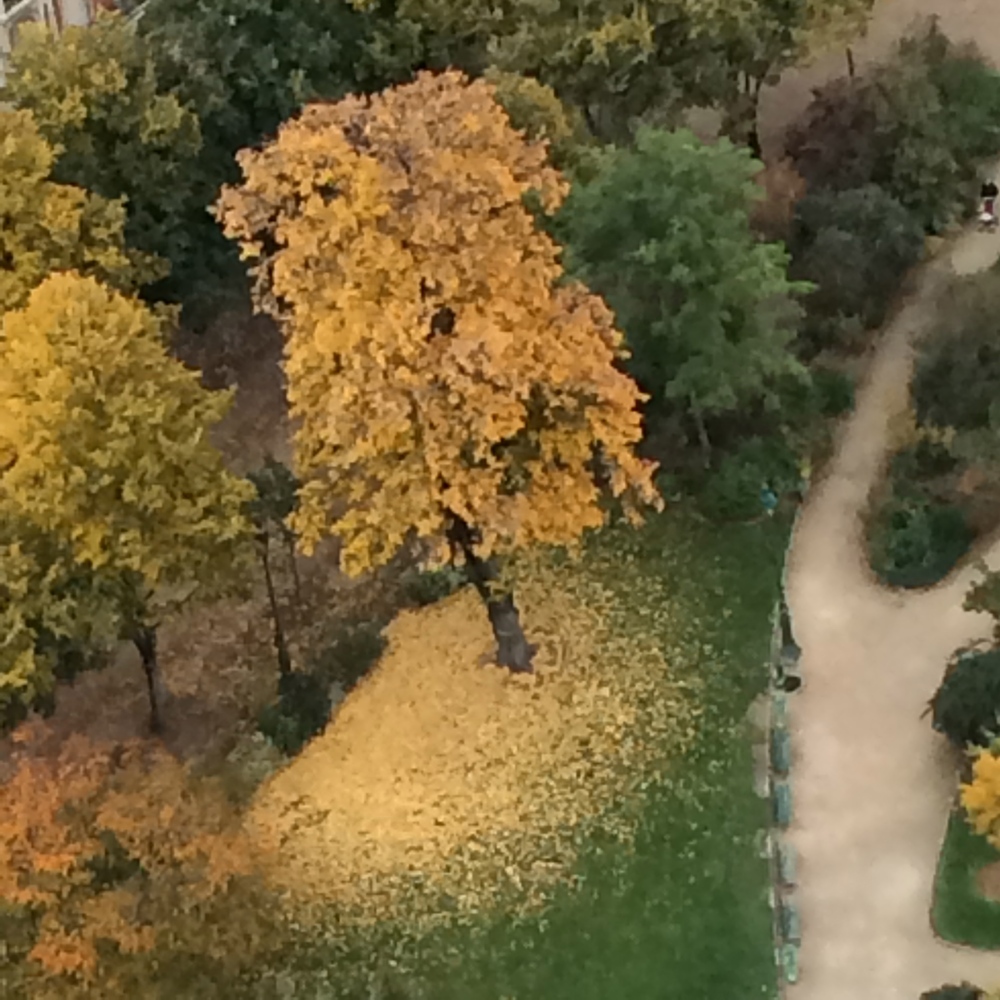
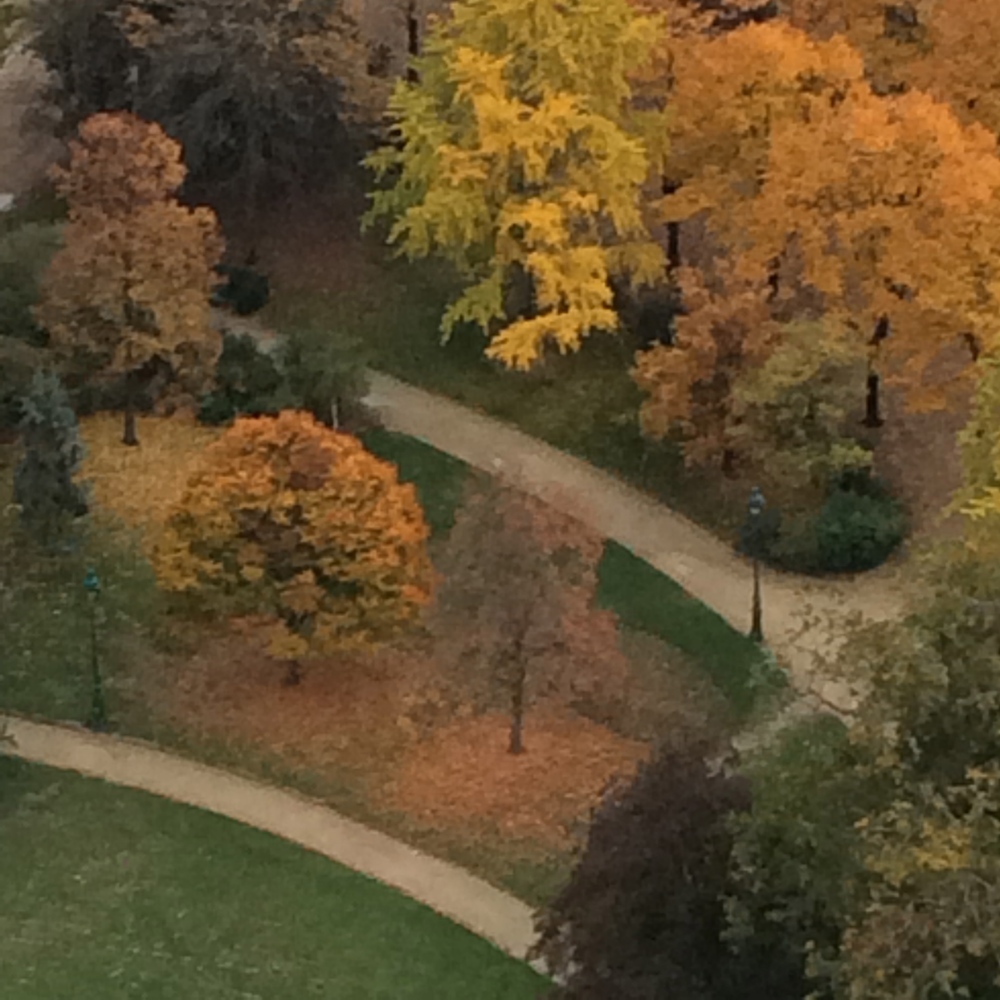
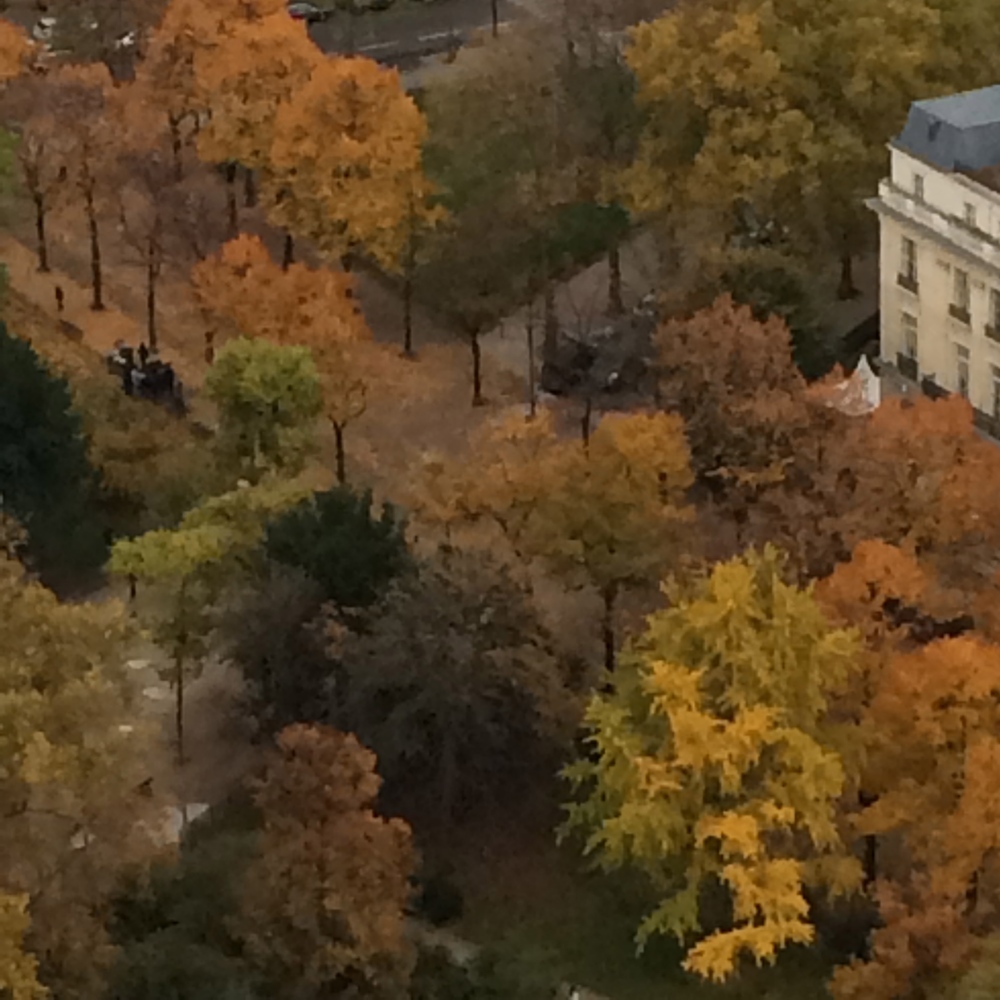 Autumn colour along a network of pale paths viewed from the Eiffel Tower
Autumn colour along a network of pale paths viewed from the Eiffel Tower
Our son is completely riveted by the whiteness of the City’s architecture. It is a privilege – and perhaps more so in retrospect – to to see this silvery city lluminated by the last rays of sunshine:
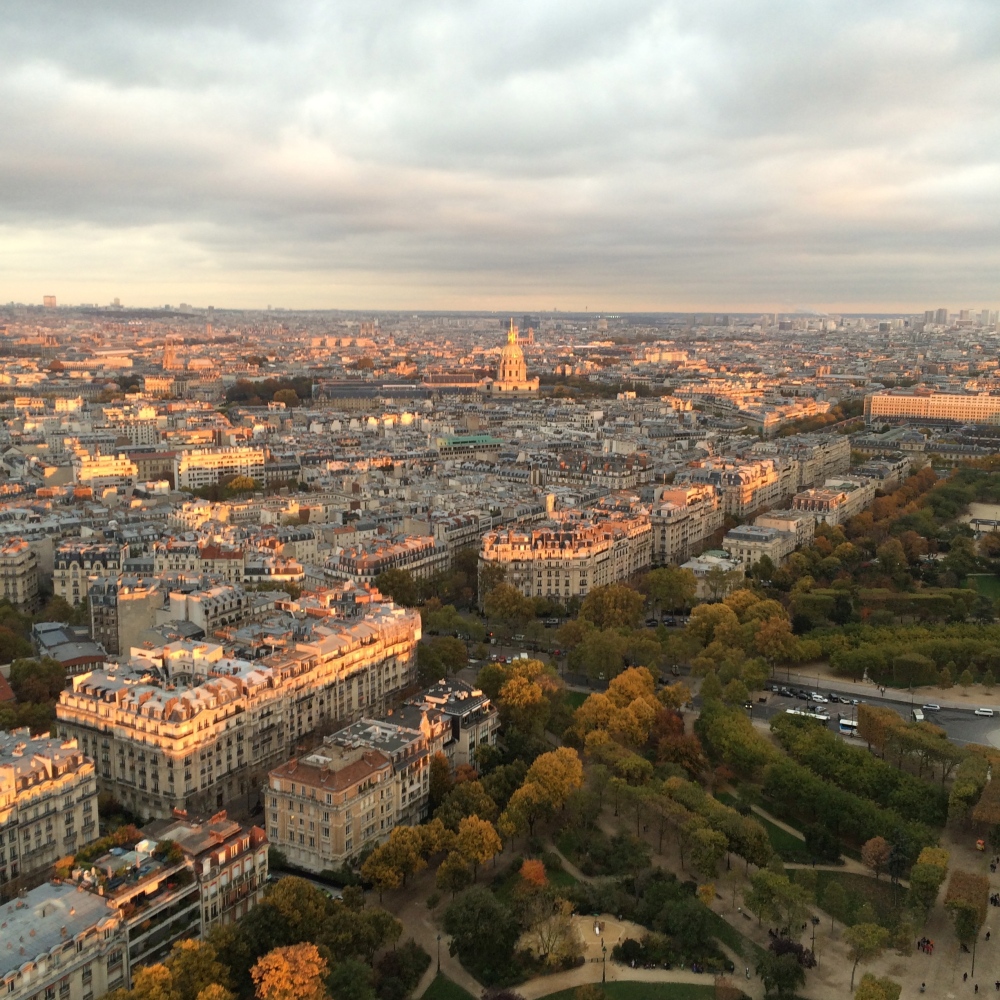 Sunset over Paris, October 2015
Sunset over Paris, October 2015
When the last burst of red sunset has gone I enjoy the scale and very French precision of the stretch of green park – the ‘Champ de Mars’ – which leads to the École Militaire:
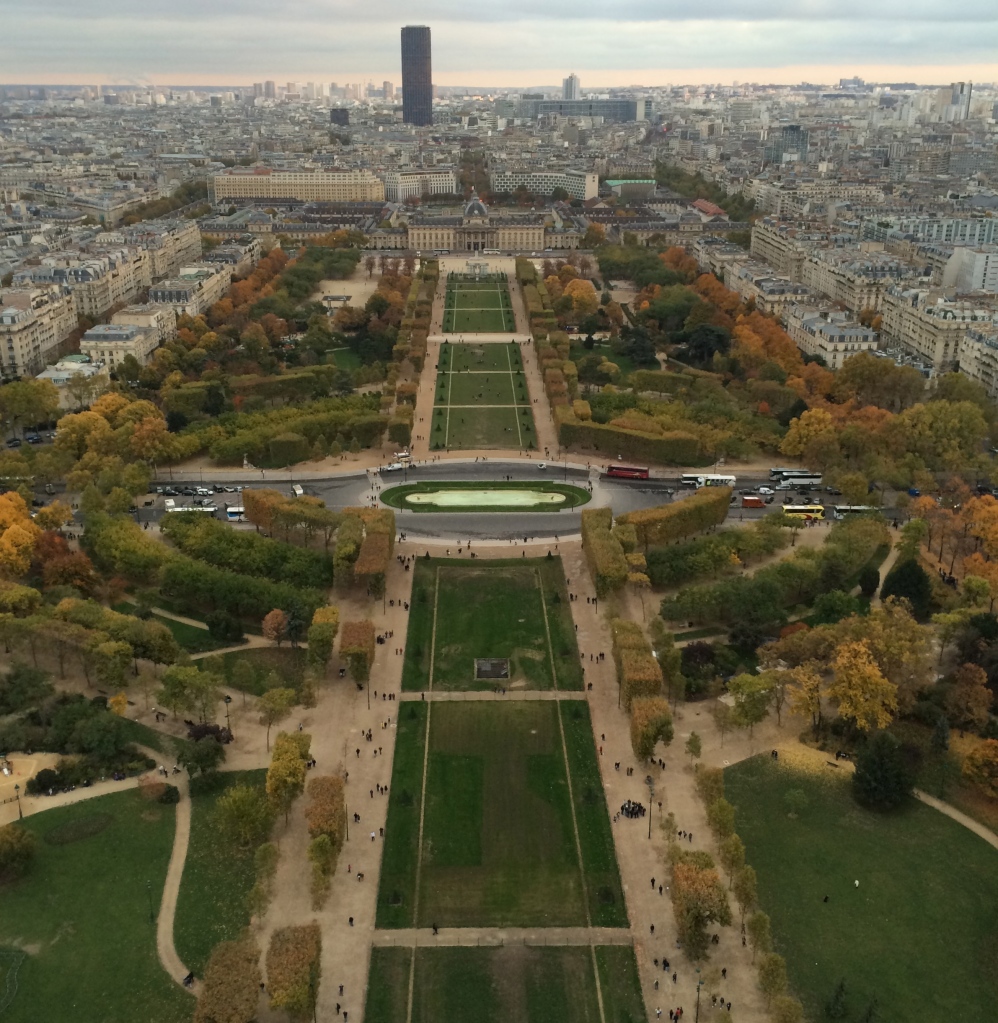 I love the pearly green of the elliptical central pool and the way the soft light of the water seems to fragment into sophisticated pockets of glowing green light as darkness falls:
I love the pearly green of the elliptical central pool and the way the soft light of the water seems to fragment into sophisticated pockets of glowing green light as darkness falls:
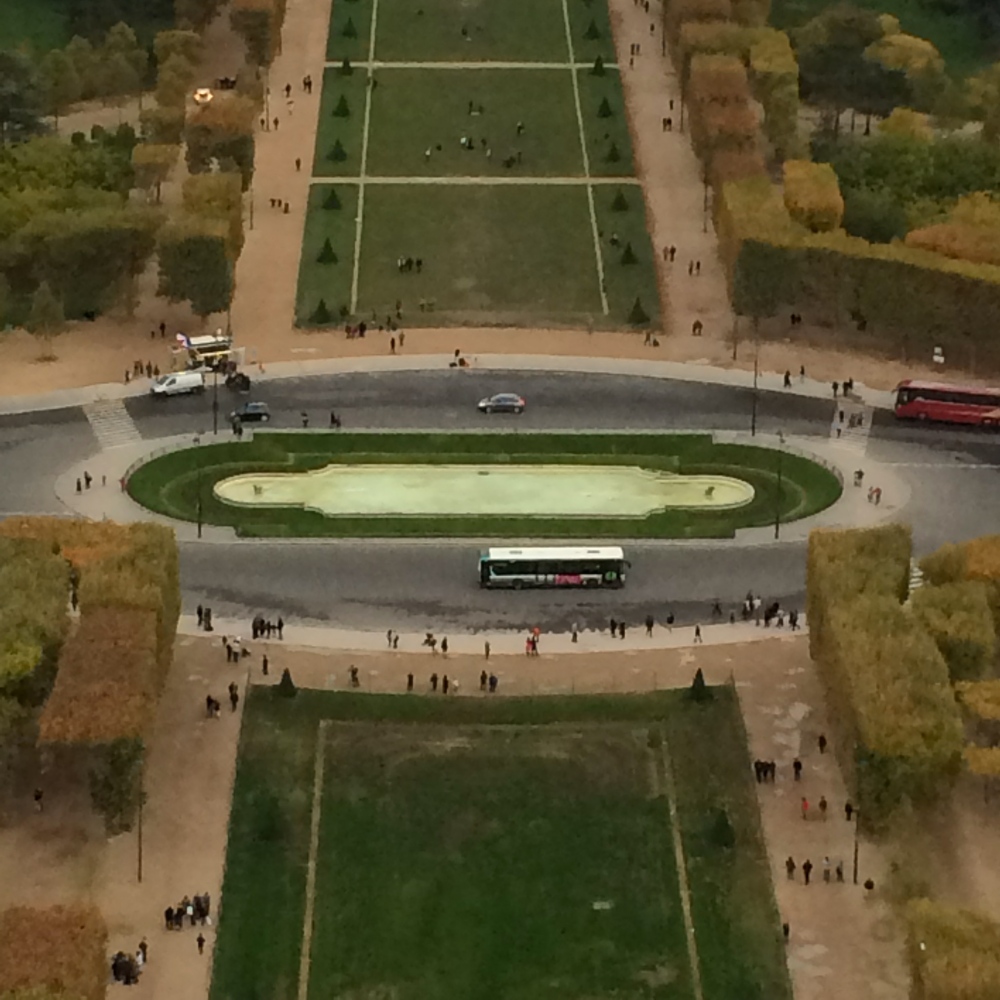 The milky green of the elliptical pool, Le Champ de Mars
The milky green of the elliptical pool, Le Champ de Mars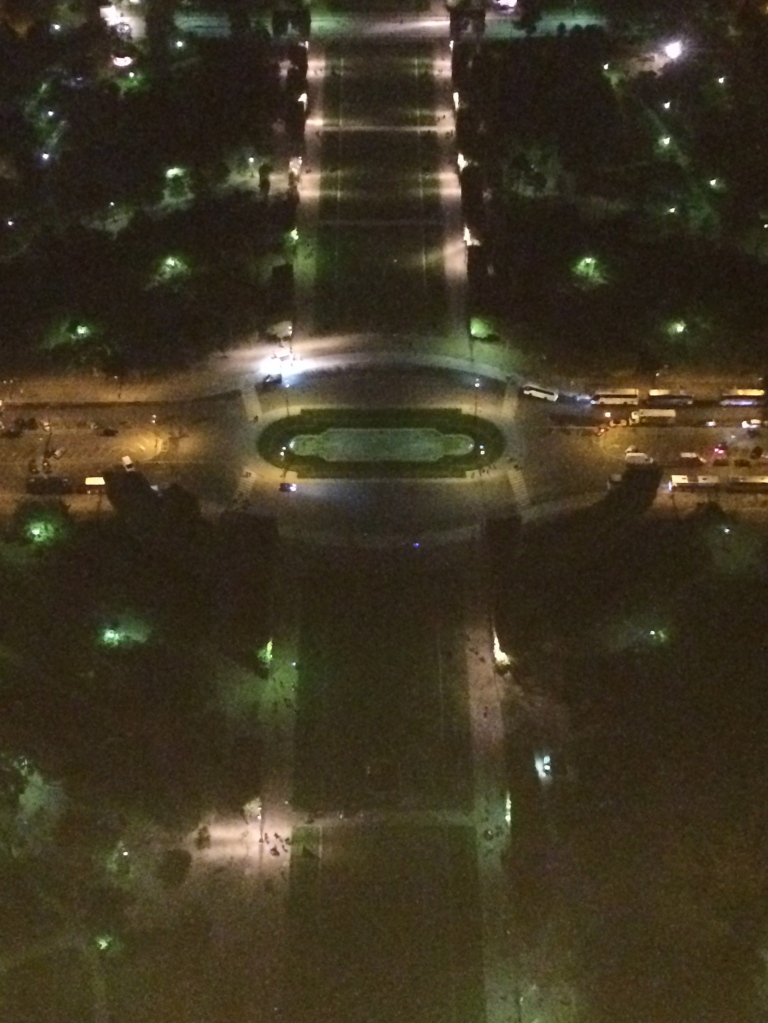
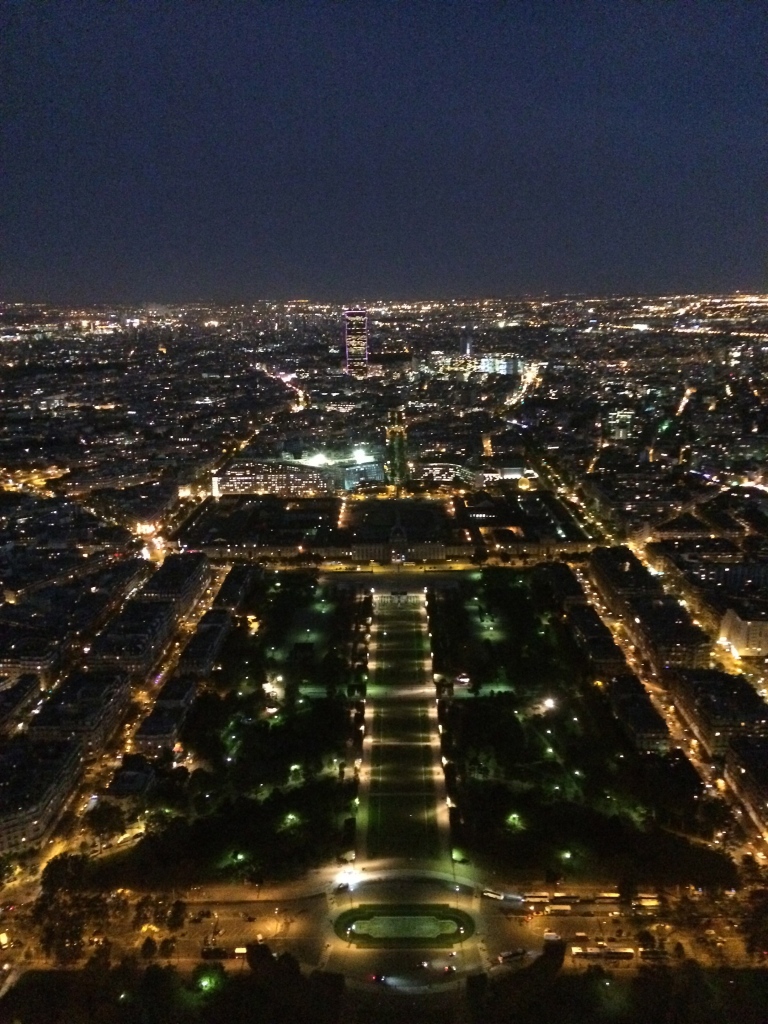 Le Champ de Mars at night – an elegant network of green lights
Le Champ de Mars at night – an elegant network of green lights
The next day we travel out to the town of Versailles, only twenty minutes from the centre of Paris by train. We have arranged to visit the grounds of the Château de Versailles – originally the hunting lodge of Louis XIII and transformed into a sumptuous palace by the Sun King, Louis XIV who moved the Court and government there in 1682, where they remained until the French Revolution in 1789.
Our plan is to get a feel for the 2000 acres or so of palace grounds – with the famous gardens, avenues of lime trees and the imposing Grand Canal designed by André Le Nôtre – and to travel around by bike. We stop first to buy a picnic lunch in a market square.
My heart stops at the sight of the perfect wooden Versailles planter, painted in a soft ‘Versailles Green’ containing a slightly ragged palm which fits perfectly with the gently sagging, peeling shutters on the building behind. Versailles planters were designed by Le Nôtre in the 17th Century so that the hundreds of orange trees at Versailles could be moved under cover for the winter with reasonable ease. They are brilliant, of course, for permanently potted trees and shrubs as the sides of the planter can be easily removed for root pruning. The ultimate source of the Versailles Planter today is the Parisian company ‘Jardins du Roi Soleil’ who make the original design under licence in different sizes and twelves classic colours using a muscly cast iron frame, solid oak from the Auvergne and heavy duty steel bolts.

Versailles Planter with palm, Versailles Green, Versailles
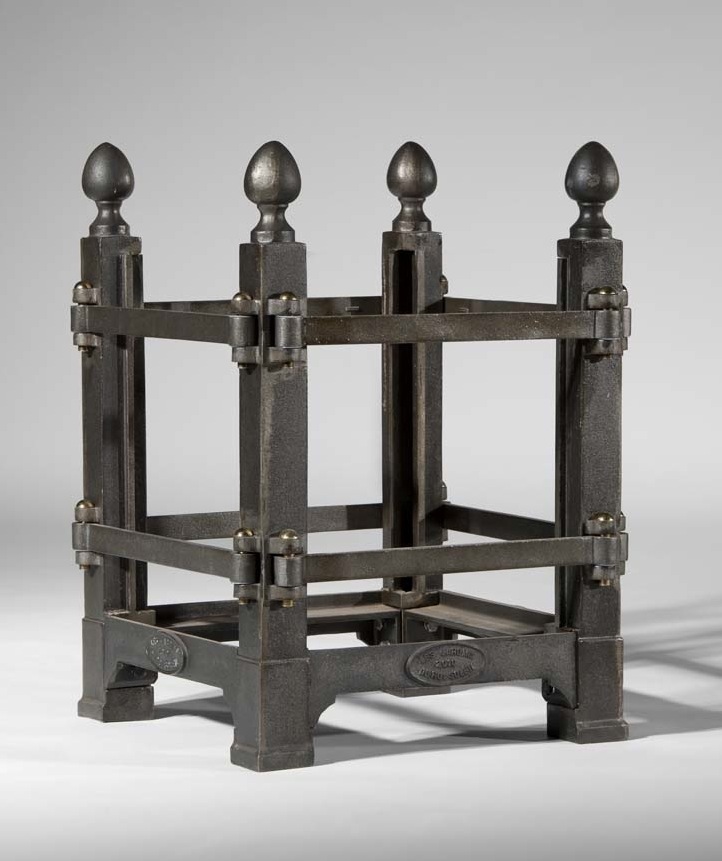 Cast iron frame of the Jardins du Roi Soleil Versailles planter
Cast iron frame of the Jardins du Roi Soleil Versailles planter
And so with our picnic in our bicycle baskets, (baguettes ‘tradition’, fresh goats cheese studded with raisins and huge, speckled yellow ‘Pommes Golden’ – completely different to the insipid ‘Golden Delicious’ apples available in the UK ) we set off through the park gates:
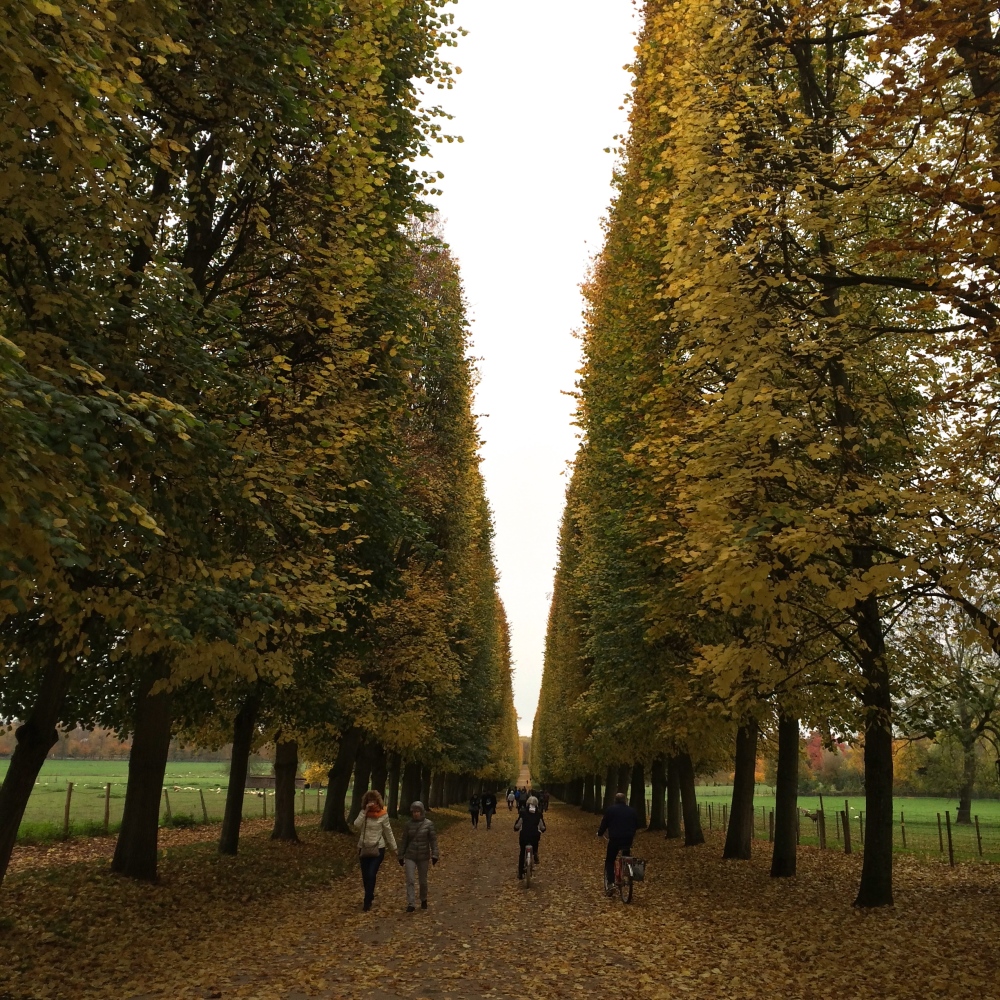 Avenue of Lime Trees, Chateau de Versailles
Avenue of Lime Trees, Chateau de Versailles
It is a perfect, gently rich moment in the year to see the park and the autumn colours are wonderful – I love the way the leaves gather in pools around the trees.
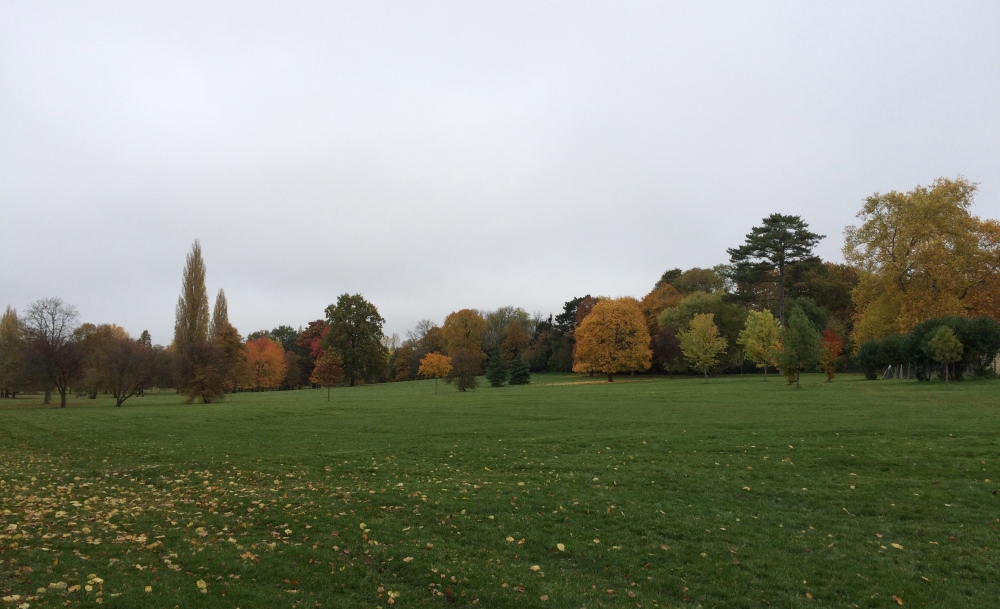
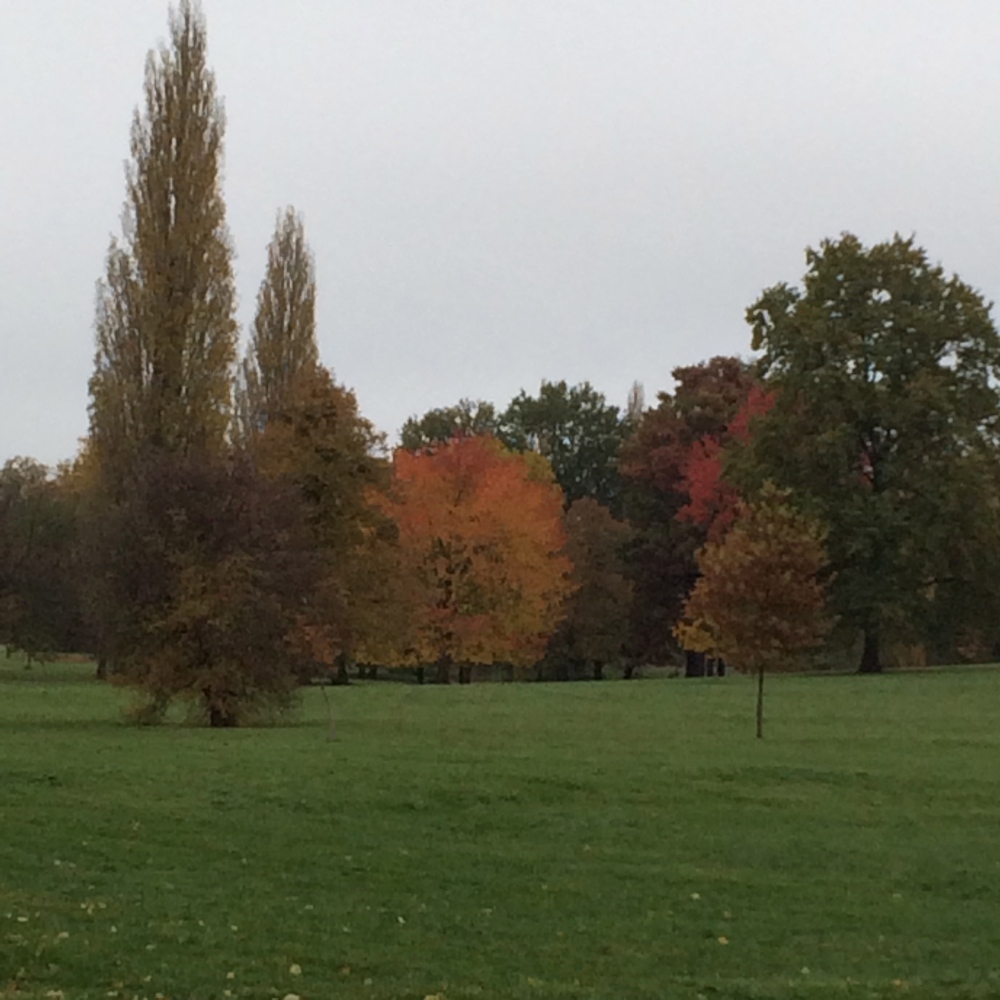
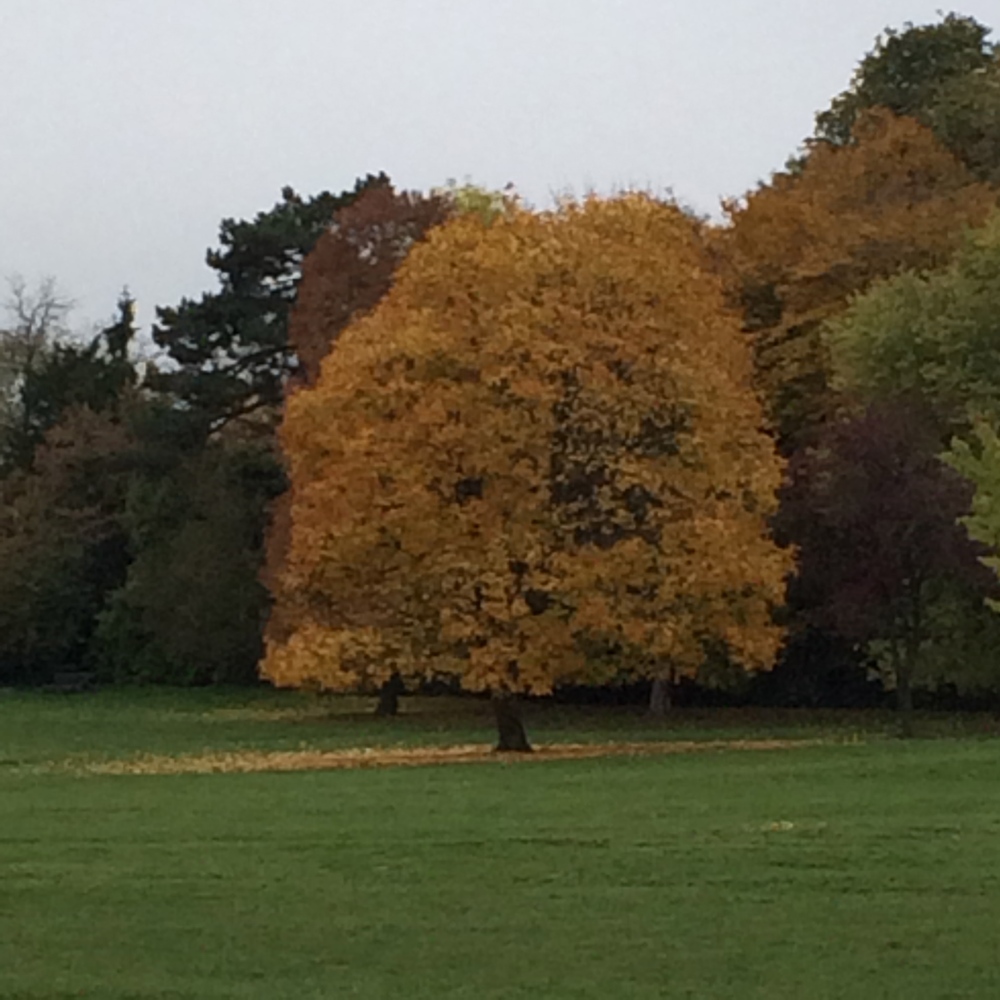 Autumn colour in the parkland, Château de Versailles
Autumn colour in the parkland, Château de Versailles
We visit the particularly curious Queen’s Hamlet given by Louis XVI to his Austrian bride Marie-Antoinette in 1783 – a model village based on rustic Normandy vernacular architecture. There are glimpses of the perfect country idyll in the individual buildings framed by neat kitchen gardens enclosed by gates and fences made from chestnut paling (see my post on the garden at the Prieure D’Orsan for really covetable uses of chestnut paling in a kitchen garden), but there is something a little forlorn about the atmosphere of this place.

The ‘Queen’s Hamlet’, Versailles

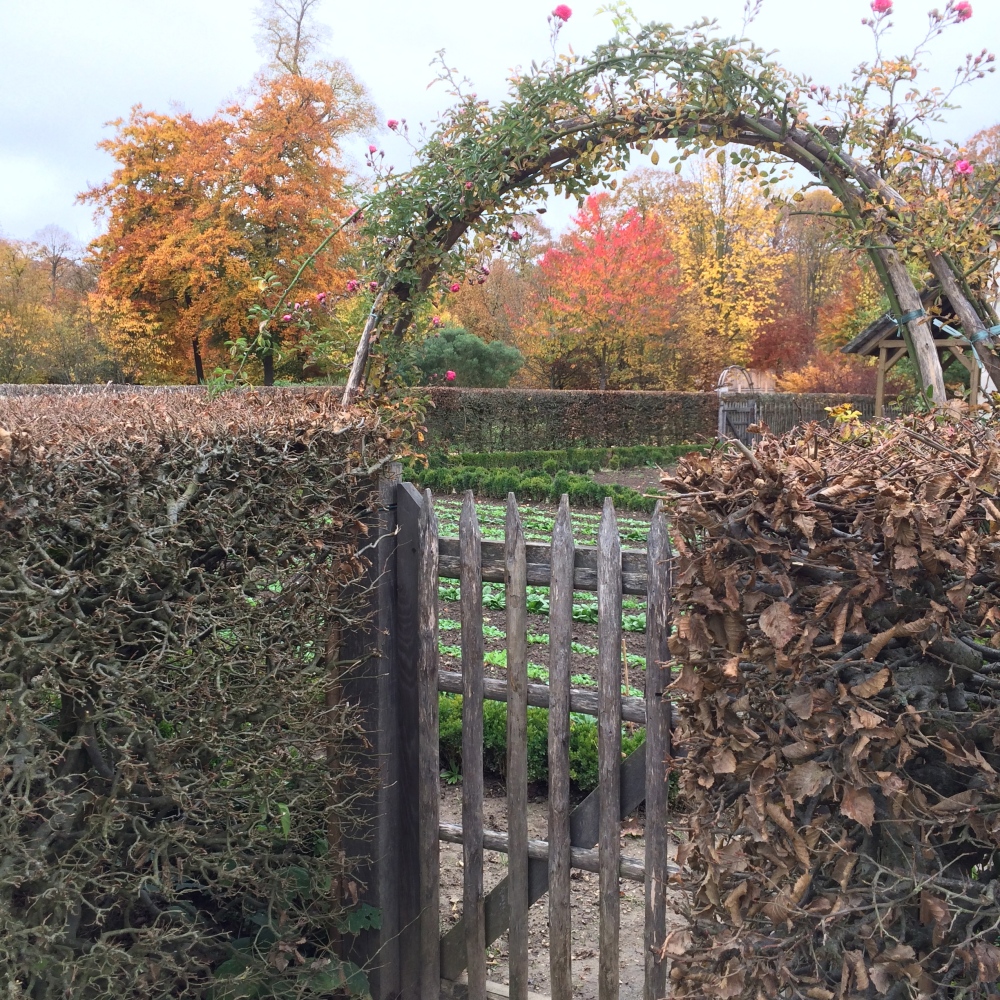
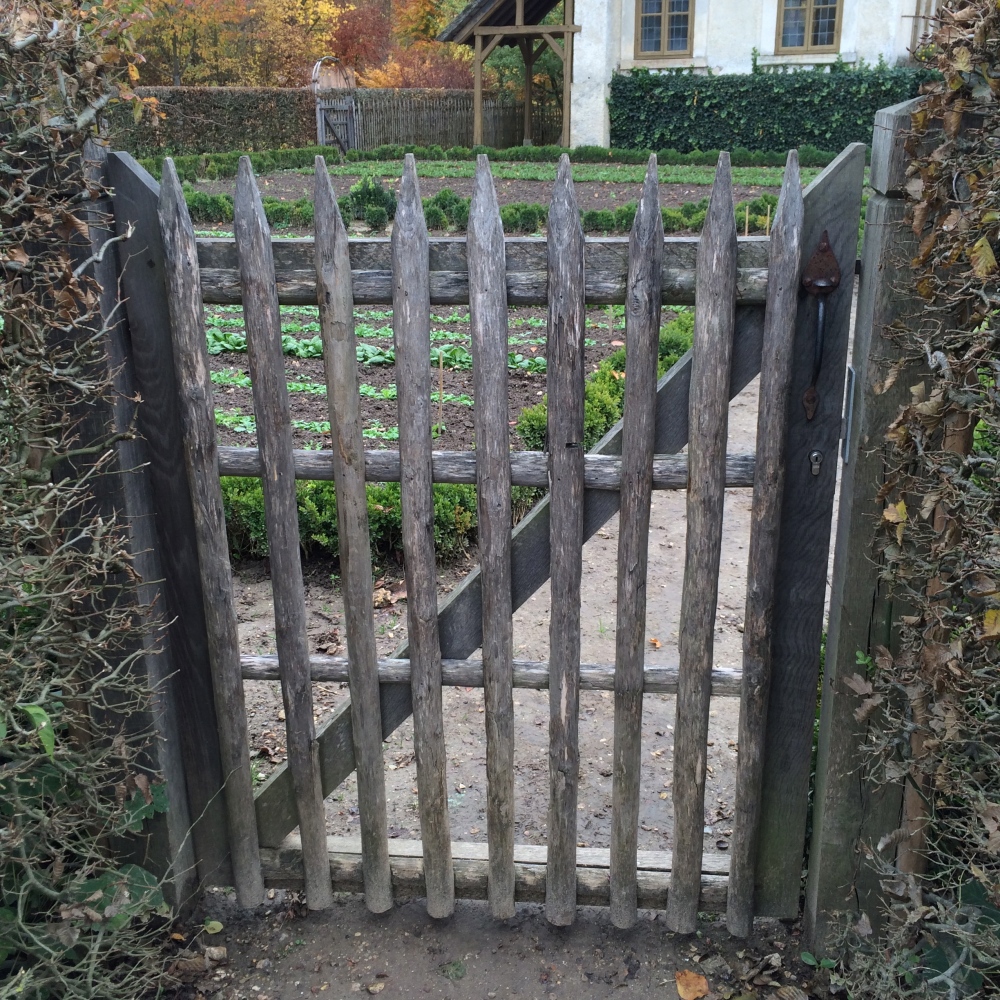
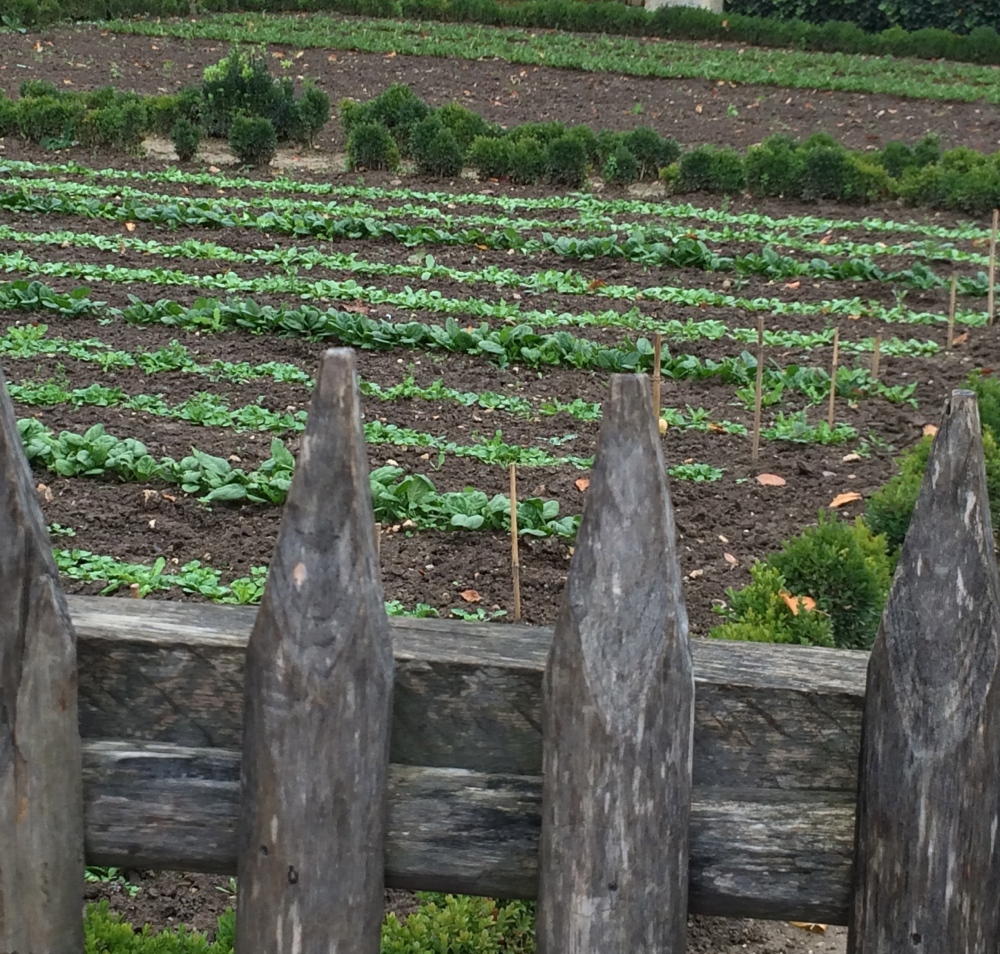 Rustic buildings with immaculate kitchen gardens, chestnut fencing and glowing autumn woodland behind, The ‘Queen’s Hamlet’, Versailles
Rustic buildings with immaculate kitchen gardens, chestnut fencing and glowing autumn woodland behind, The ‘Queen’s Hamlet’, Versailles
In the more relaxed, fiery woodland surrounding the hamlet we sit for a while admiring this fine Malus transitoria – my favourite crab apple – which has a spreading cloud of white blossom in May and in autumn hundreds of tiny yellow fruit which hang like miniature pumpkins from crimson stems.
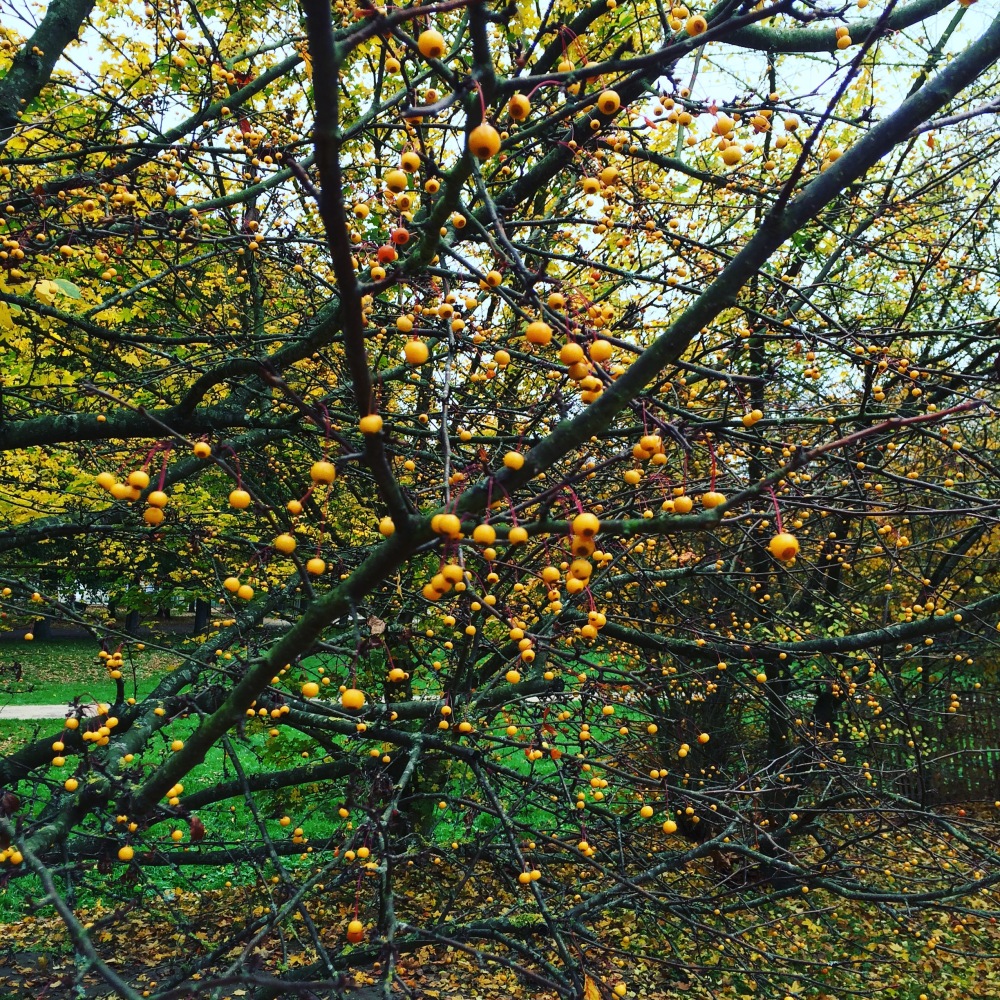
Malus transitoria
We cycle away towards Le Grand Trianon – built in 1687 for Louis XIV and described modestly by its architect, Mansart, as ” a little pink marble and porphyry palace with delightful gardens”. The soft pinks and beiges of the palace frames the autumnal woodland beyond perfectly. It is interesting that Napoleon Bonaparte had the palace restored after the Revolution and enjoyed staying there with his wife, Empress Marie-Louise, and that in 1963 Charles de Gaulle had it restored and modernised for use as an official Presidential Residence.
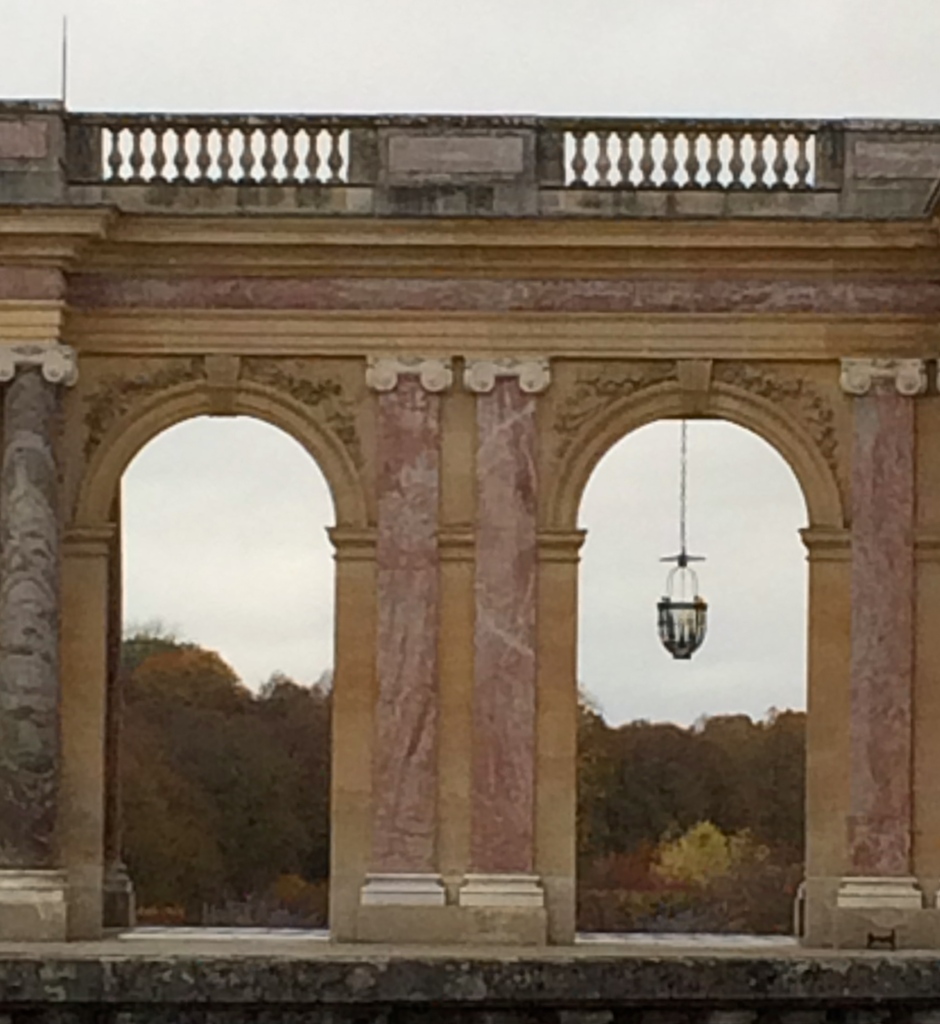
The pink and beige arches of the Grand Trianon provide a perfect frame for the autumnal woodland beyond.
The regimented avenues of fastigiate hornbeam opposite the Grand Trianon are exhilarating in the richness of their gold leaves and the soaring precision of the way they are so grandly ordered.
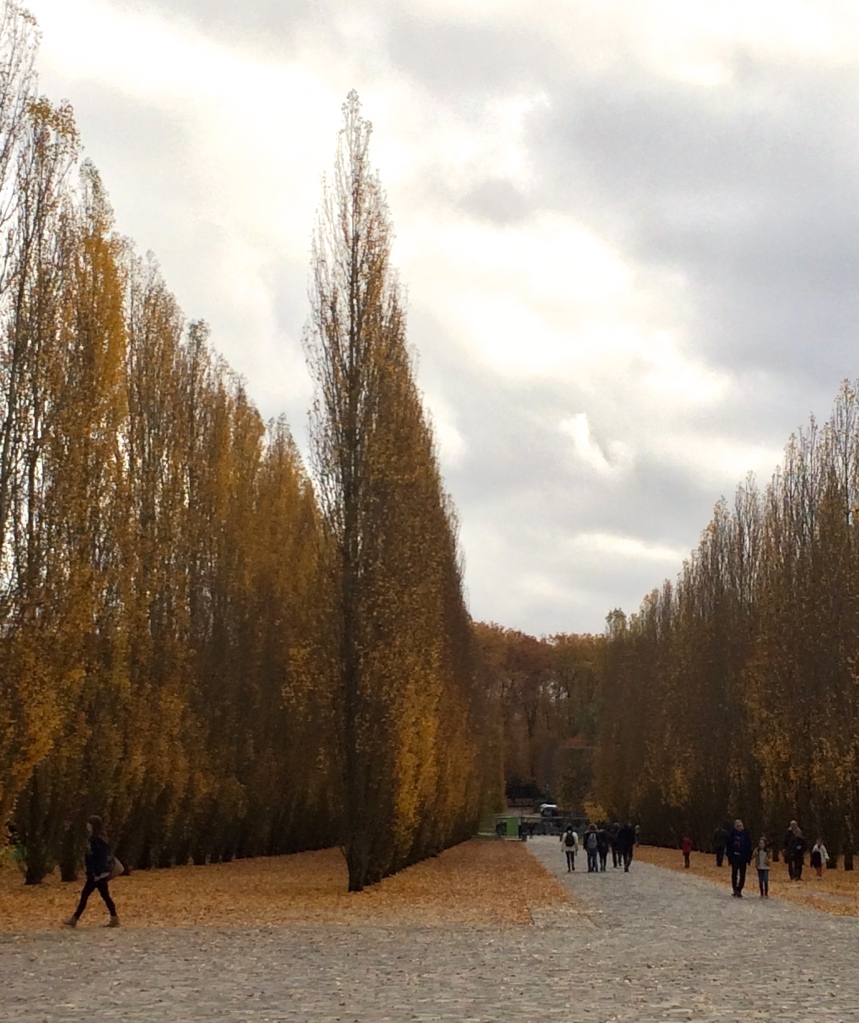
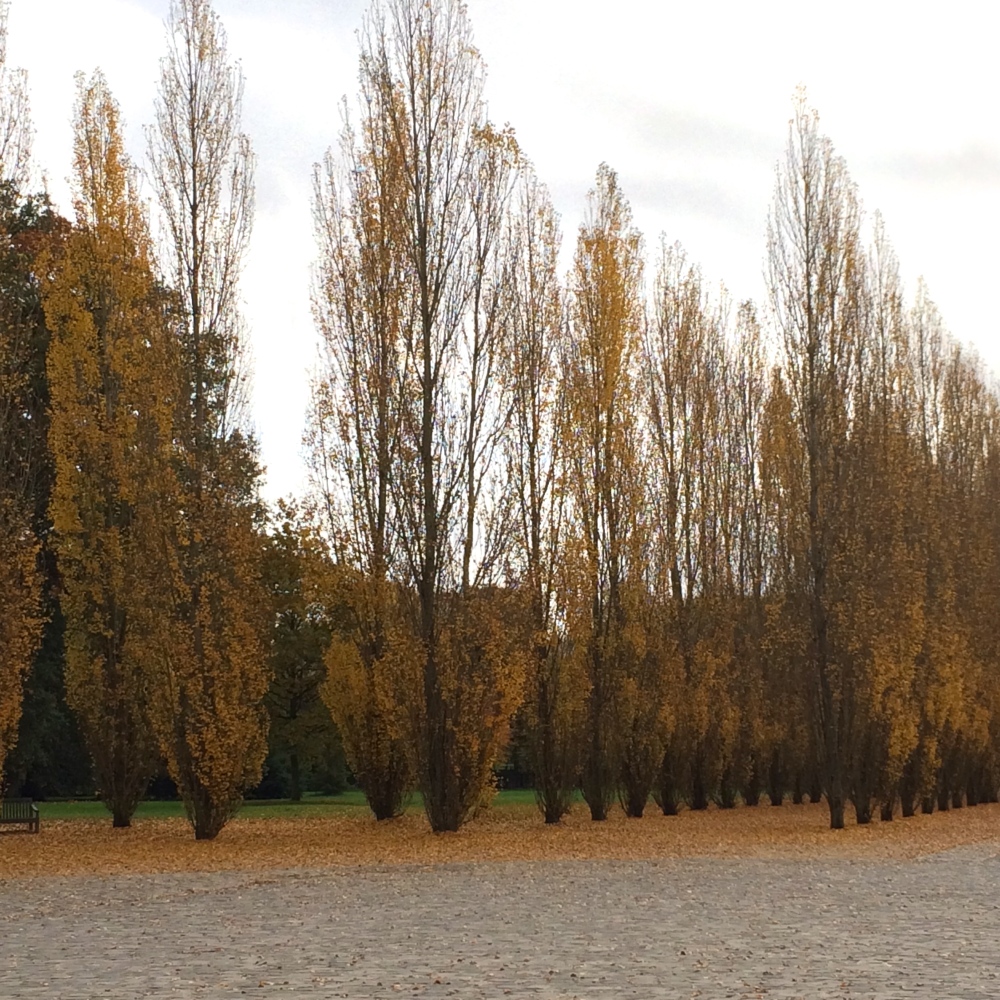
Elegant avenues of fastigiate hornbeam
We cycle five or so kilometres around the Grand Canal and picnic at the far end enjoying the late afternoon sun lighting up battalion after battalion of impeccable lime tree:
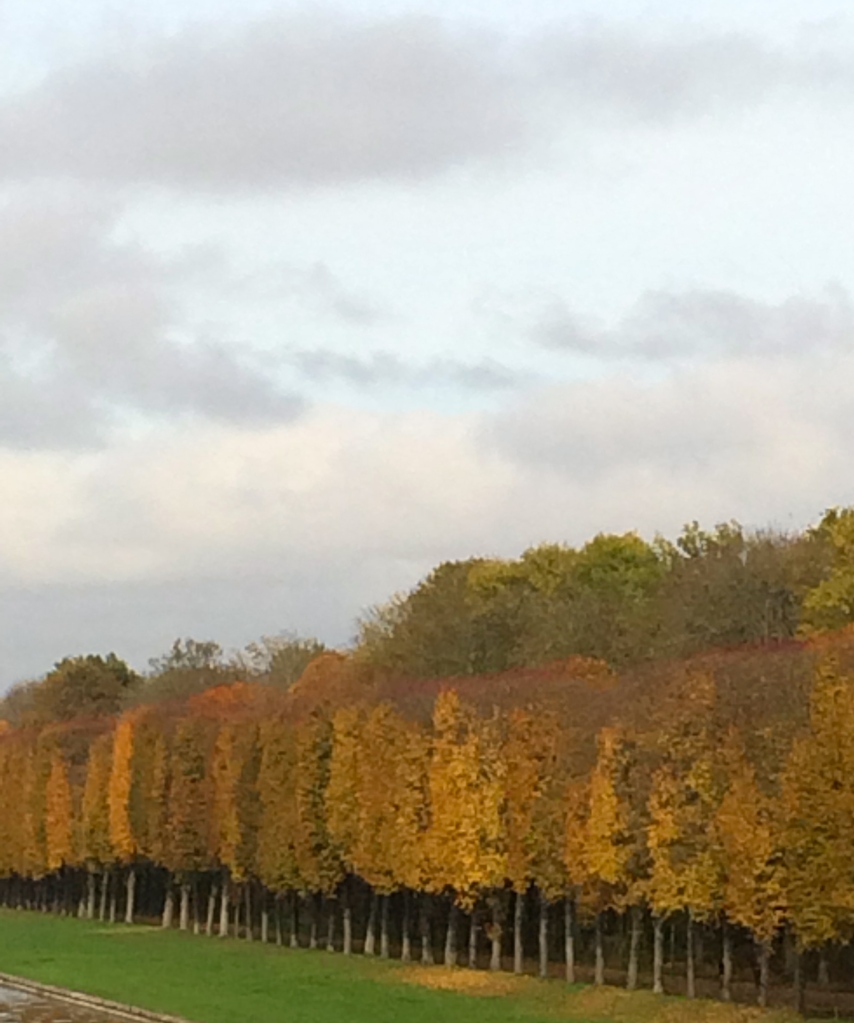
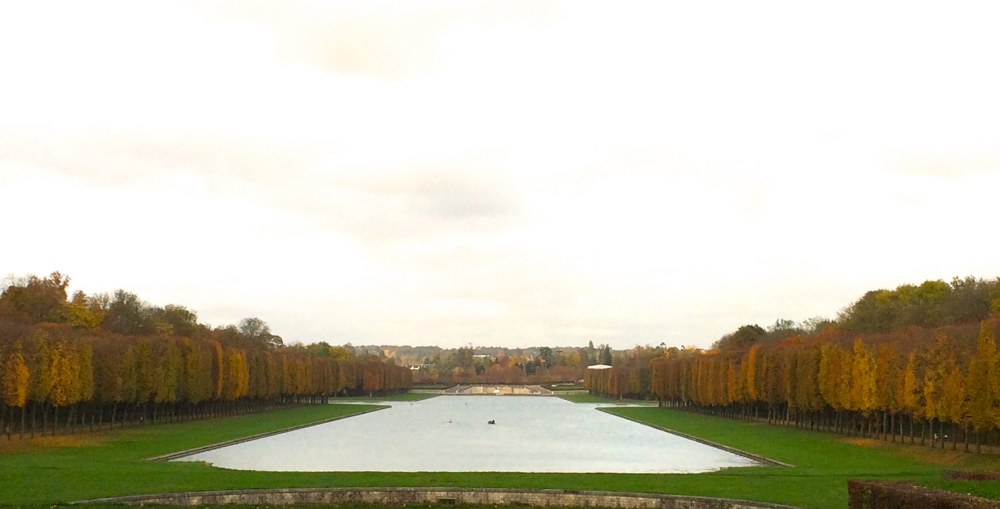
Regiments of lime trees around the Grand Canal, Versailles catching the light
Inside the Palace itself it is a crazy international tourist bunfight, everyone wanting a piece of the dazzling Hall of Mirrors and the King and Queen’s ‘Grand Apartments’. We have something else to catch before dusk so we hurtle through. I stop for a moment amongst the bustle to admire the brilliant succession of jewel-like colour in the rooms I am walking through. It would be wonderful to design a contemporary formal garden inspired by this intensity of colour – with a blue garden room, behind which is a garden of brightest green, and behind that perhaps a red garden and then a magenta garden …
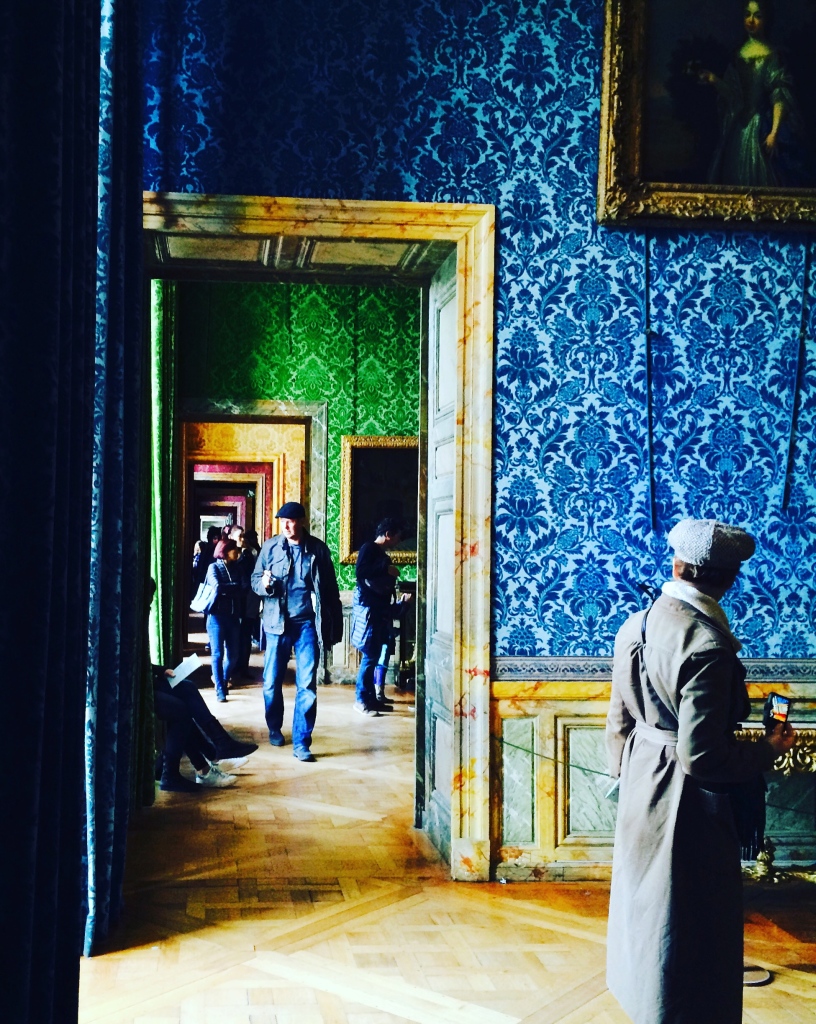
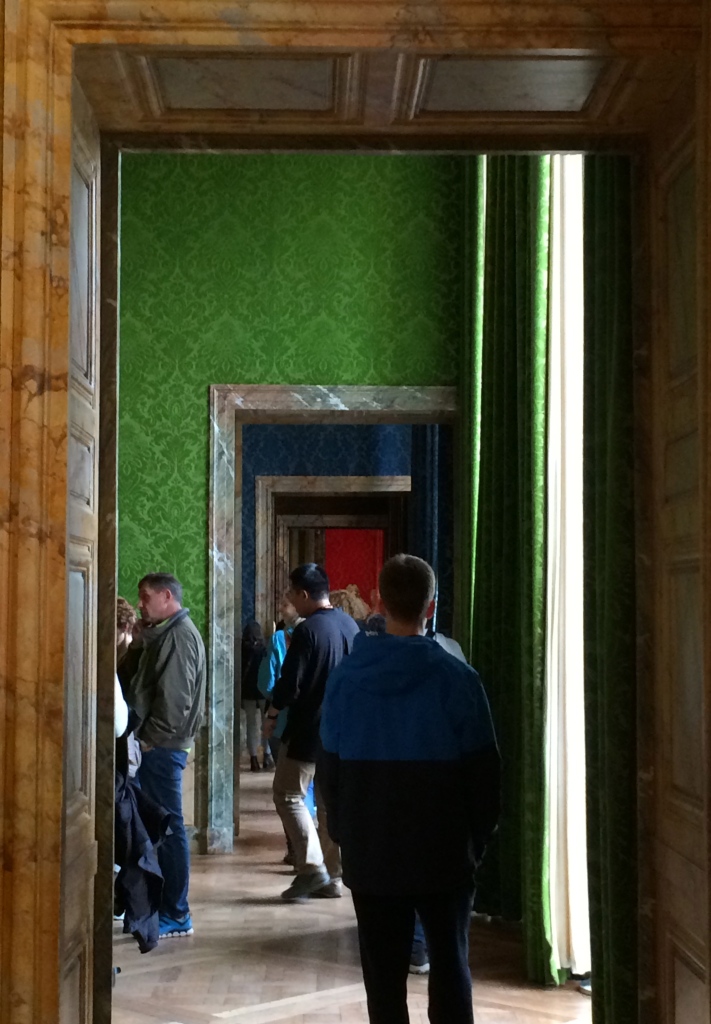
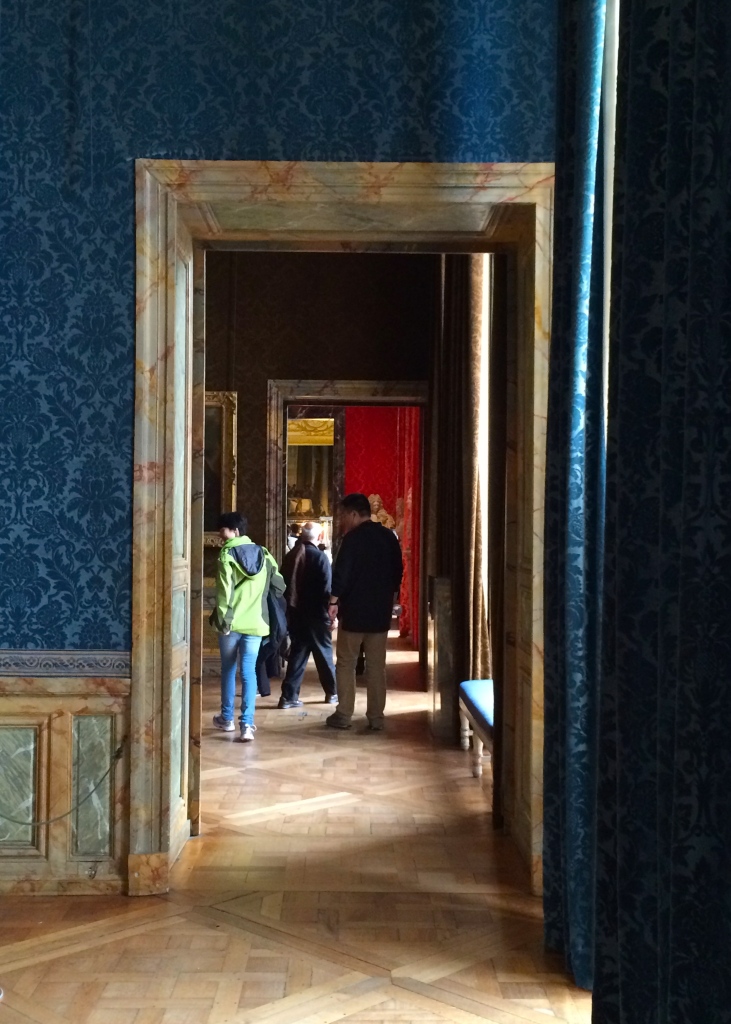 Room upon room of intense colour in the Palace of Versailles
Room upon room of intense colour in the Palace of Versailles
As I look through the window, every element of the garden beyond is so finely balanced – the perfect velvetiness of the clipped yew, the pristine white of the statuary, the shell pink of the paths and the hazy softness of the woodland beyond – that I cannot believe it is quite real.

View onto immaculate Palace Gardens, Versailles
The light is fading, but the Potager du Roi (The King’s Kitchen Garden) is only a walk away from the main palace and I cannot leave without at least a glimpse.

Original plan for the Potager du Roi
The 22 acre potager was created for Louis XIV by Jean-Baptiste de La Quintinie who was named first director of the garden in 1670. The original site was swampland and completely unsuitable but the King was keen on fine fruits and vegetables – especially when tantalisingly out of season – and so the site was cleared, drained, filled with good soil and it was the architect Mansart, again, who designed a series of terraces and walls that would create particularly hospitable micro-climates for certain fruits and vegetables. La Quintinie must have been thrilled to note that he was successful in producing “strawberries at the end of March … peas in April, figs in June, asparagus and lettuces in December, January …” He raised fifty varieties of pears, twenty varieties of apples and sixteen different types of lettuce for the King’s table. Louis XIV would send samples of his favourite pear, ‘Williams Bon Chrétien’, as a gift to heads of state and the brilliant letter writer, Mme de Sévigné remarked drily on the fashionable fervour for the finest produce “the craze for peas continues; the impatience of waiting to eat them, to have eaten them, and the pleasure of eating them are the three subjects our princes have been discussing for the past four days now”.
Almost as soon as we enter the Potager we come across an entire wall of figs with purple fruits and leaves turning a deep yellow:
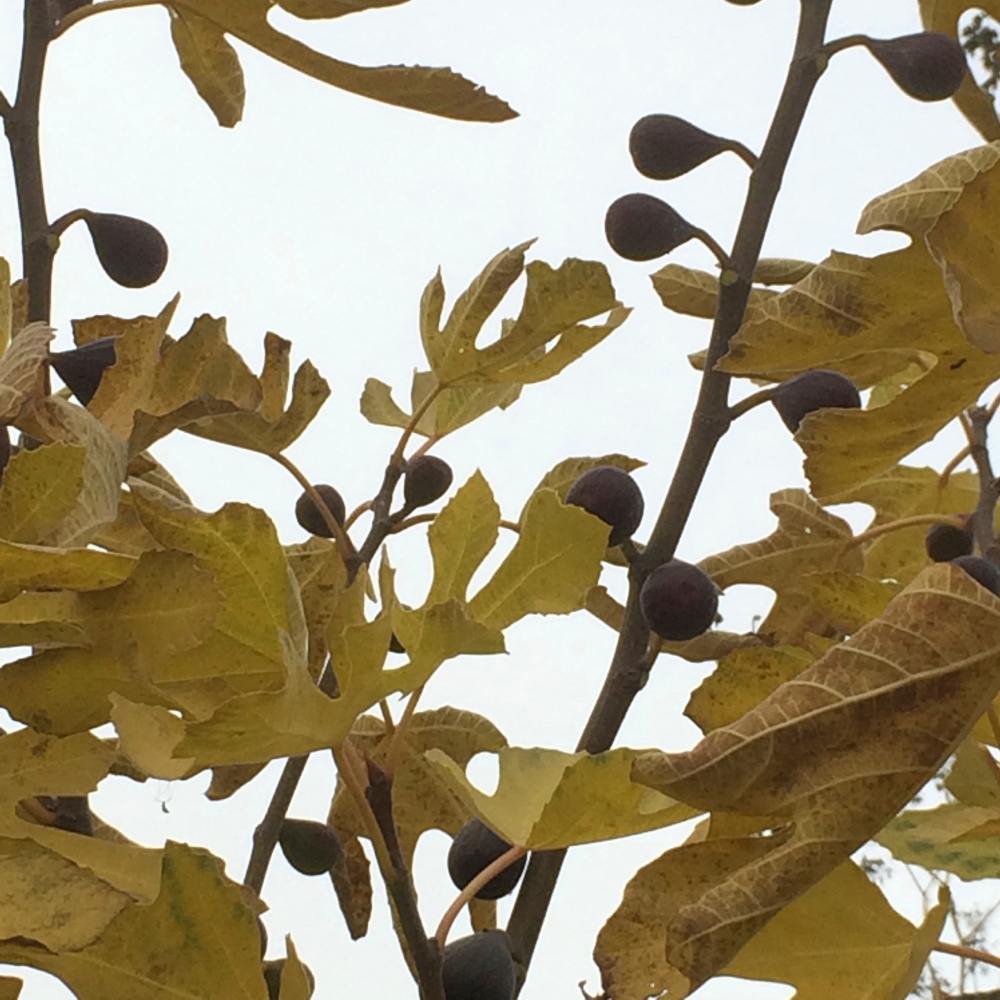
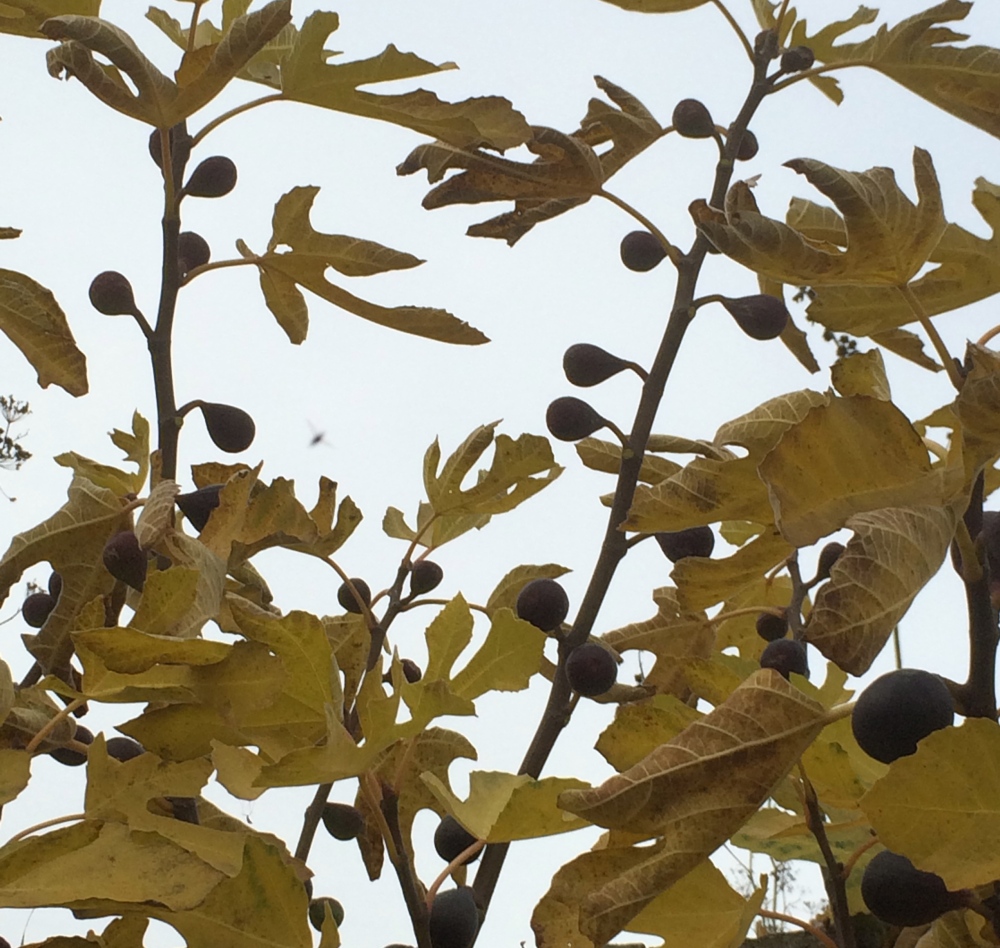 wall of figs, Potager du Roi, October 2015
wall of figs, Potager du Roi, October 2015
This is modest of course compared to the pre Revolution ‘Figuerie’ – a sunken garden dedicated to the production of 700 fig trees grown in pots so they could be moved and housed under glass each winter – but it is a gorgeous sight and I step further into the garden.
It feels a slightly unfair moment to visit this incredible collection of 450 varieties of fruit trees, including 5000 espalier trees and possibly the world’s largest collection of fruit trees pruned into historic forms – now also the home of the National School of Landscape Architecture (ENSP) – but even now as the light is fading the variety of shape and tireless skill sing out.
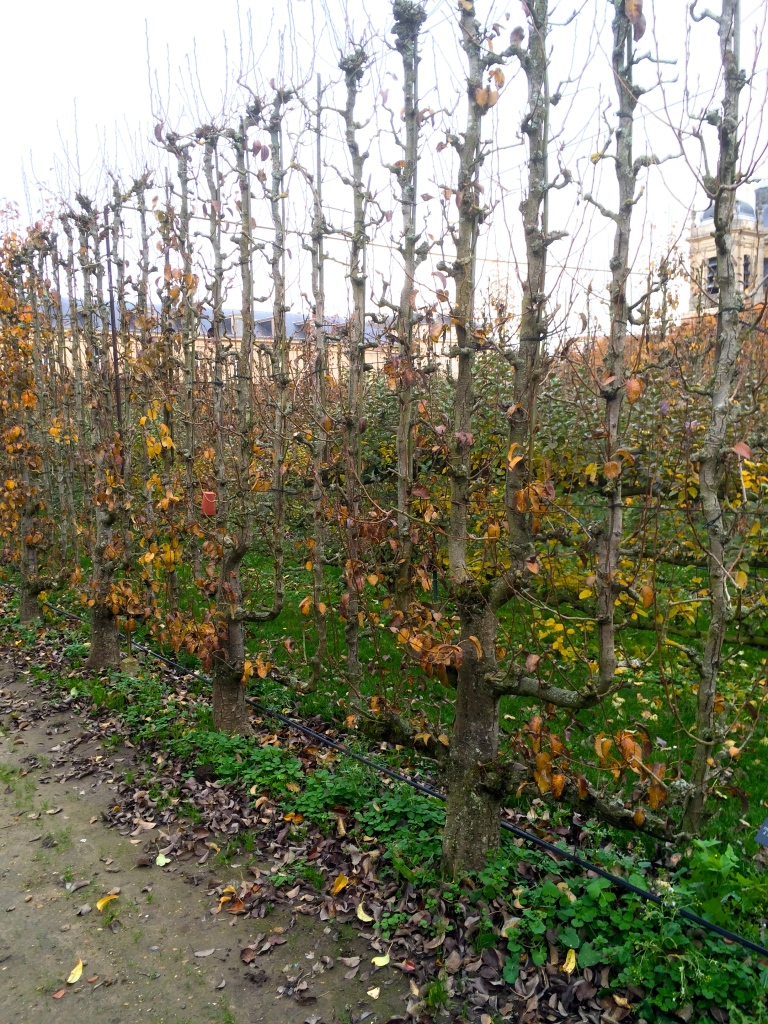
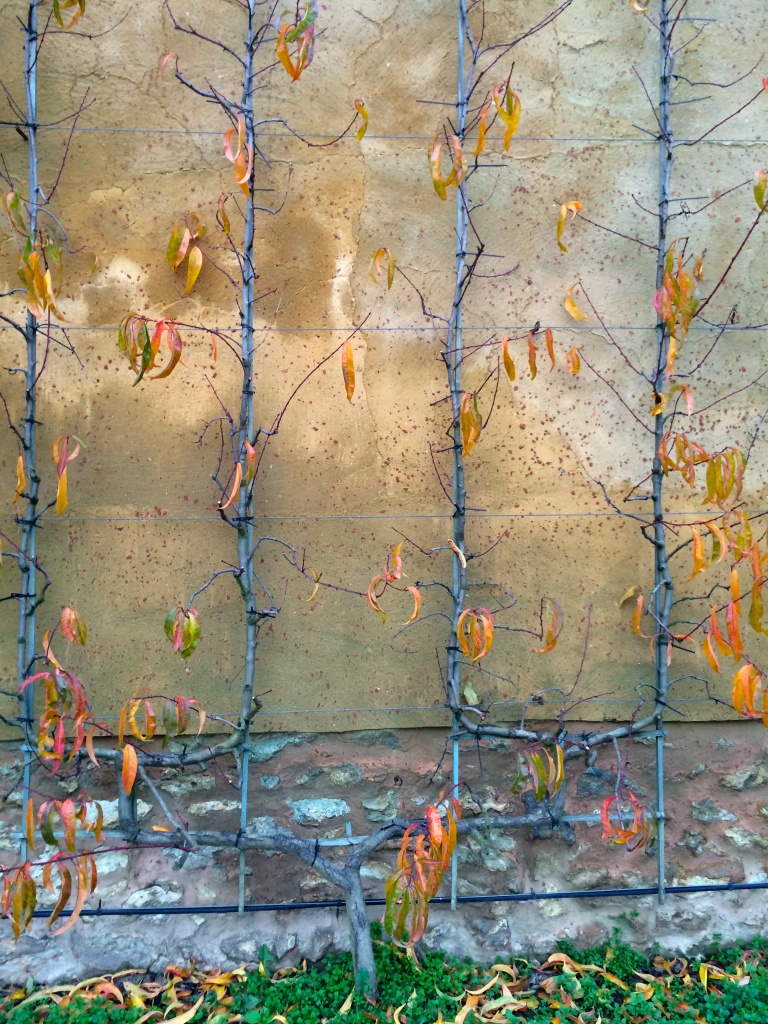
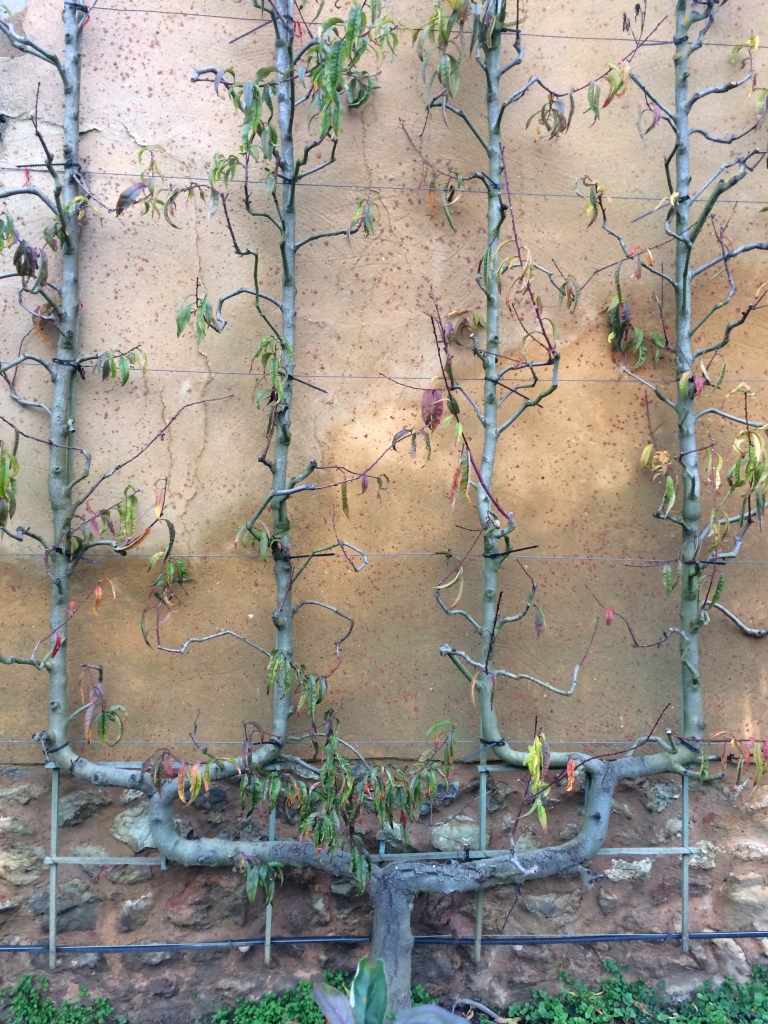
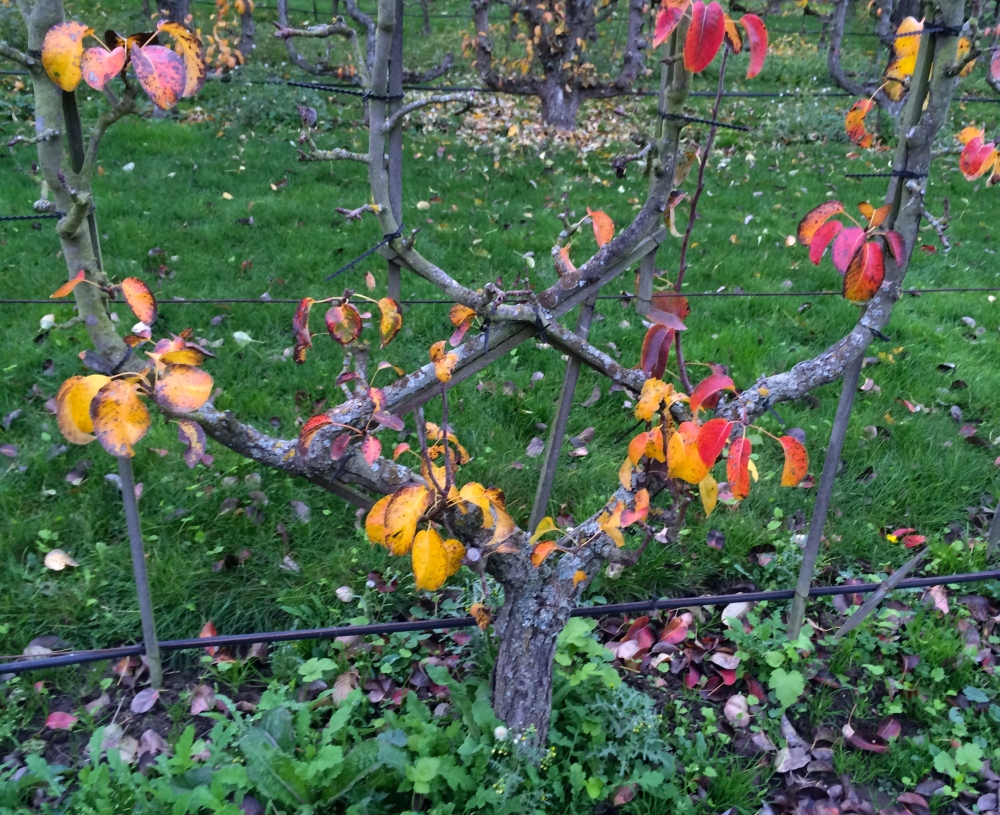 A tiny sample of trained apple and pear trees, Potager du Roi, October 2015
A tiny sample of trained apple and pear trees, Potager du Roi, October 2015
This is a garden of experimentation which has moved with the times and is always trying something new. The slightly unkempt feel to the garden is due to the more recent approach to let the grass grow up amongst the rows of trees to encourage the presence of insects and other natural predetors and reduce/eliminate the need for chemical controls.
My heart goes out to the row of ‘Reine Claude’ greengages which are being trained into ‘Palmiers concentriques’.
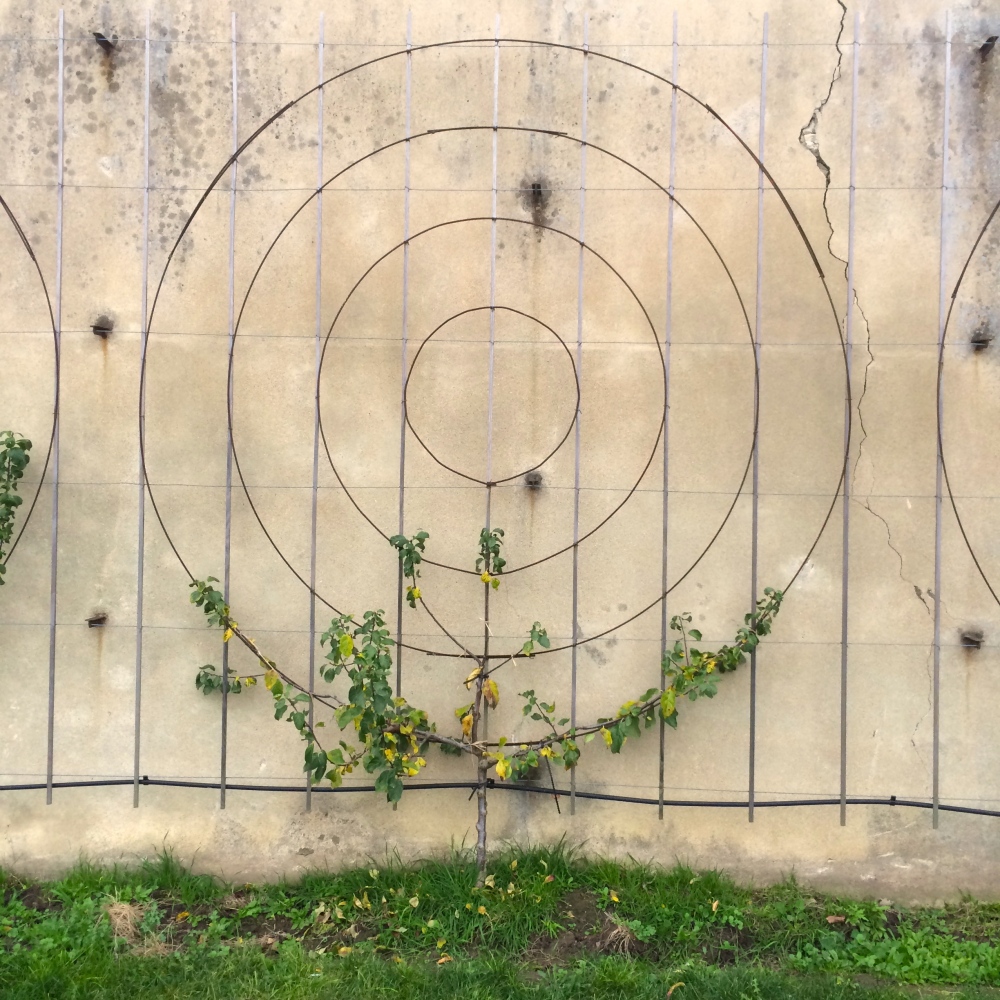
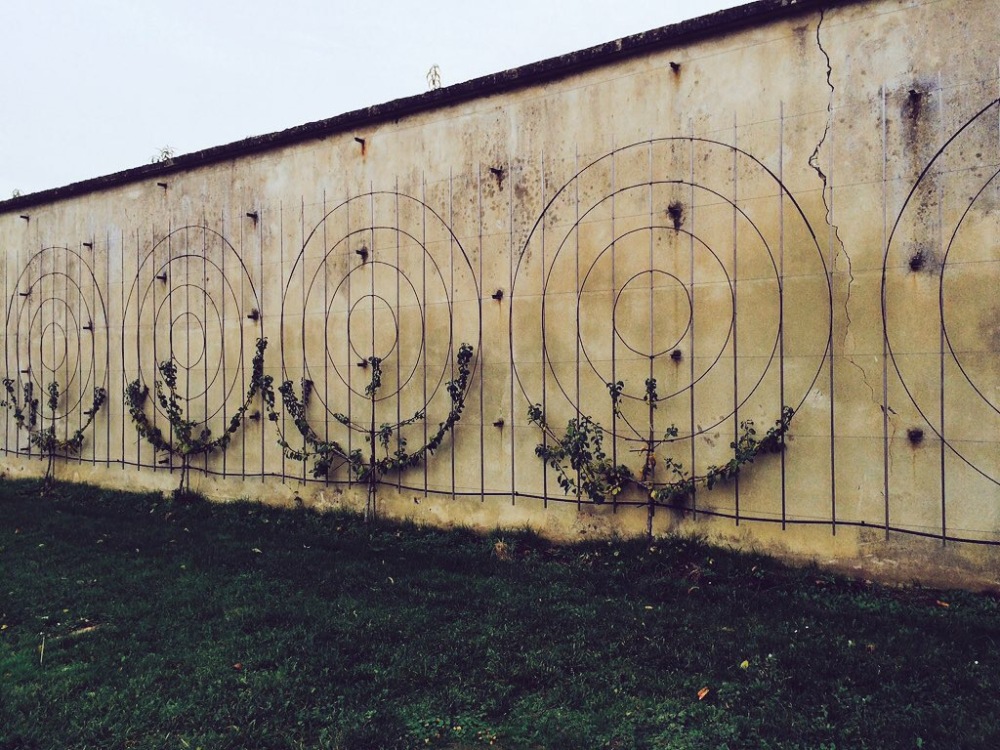 Reine Claude greengages being trained into circles, Potager du Roi
Reine Claude greengages being trained into circles, Potager du Roi
And I am smitten by the tall walls of white peaches – including the white fleshed ‘Donut’ peach, Saturn – which are grown as double vertical ‘wavy’ cordons – ‘cordon vertical ondulé double’.
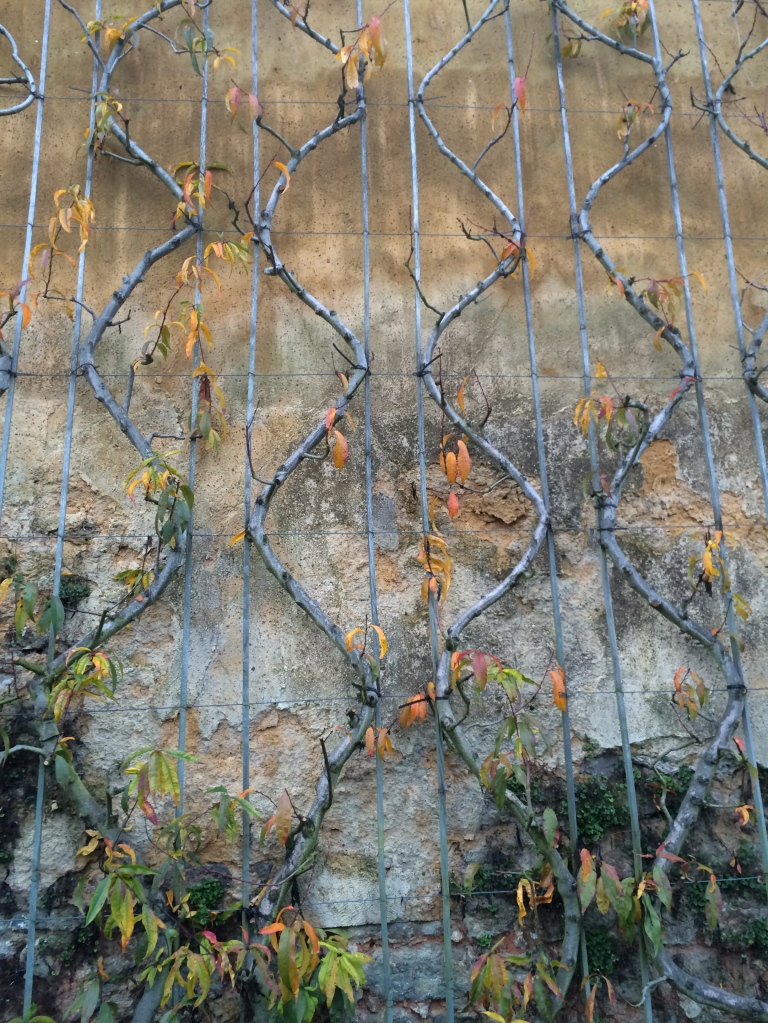
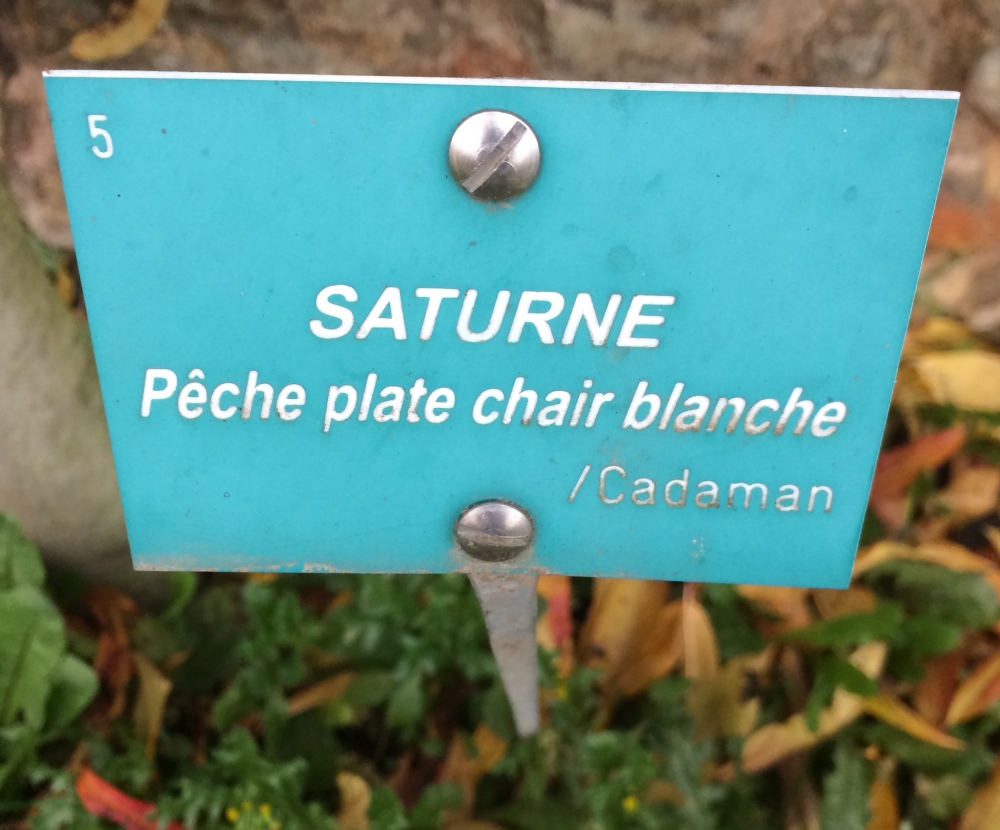
Double wavy cordons of white fleshed peach, Potager du Roi
Although there are fine examples of this kind of fruit tree training elsewhere, France is undoubtedly at the forefront of this painstaking art. If you want to know more you must turn to Jacques Beccaletto’s extraodinary ‘Encyclopédie des Formes Fruitières’ which continues to be a five star recommended bestseller even on UK Amazon.
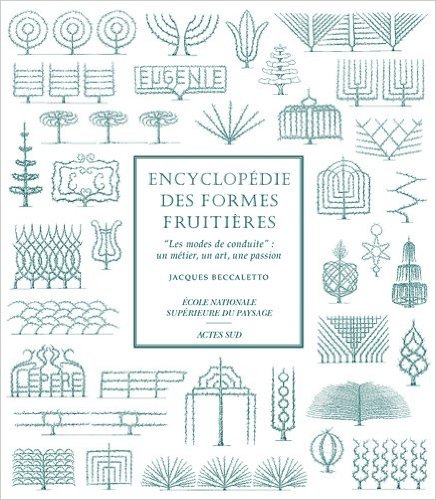
Encylopédie des Formes Fruitières
Everything I discover about the Potager du Roi makes me want to come back for more in the spring. Historic varieties of fruit and vegetables are regularly re-introduced and selection is based on taste as well as rarity. The garden is keen to champion diversity in everything it grows and is determined to remind us that strawberries, for example, need not be the glossy giants available in supermarkets today – instead they grow varieties such a ‘Versaillaise’, ‘Vicomtesse Héricart de Thury’ and ‘Capron Royal’ which have relatively modest crops of small sweet fruits.
Back in London, thinking about the crucial work being undertaken in Versailles to keep local heritage varieties of fruit and vegetables from dying out, I am delighted by the timing of a message from Amy Goldman: she tells me that the Potager du Roi is ‘one of her favourite places on Earth’. For the last couple of days her gorgeous and powerful new book, Heirloom Harvest has been distracting me from other tasks. I was introduced to Amy by the exuberant New York artist and plantswoman, Abbie Zabar (see my May 11th 2015 post ‘An English Gardener in New York, Part 1). I love the way that gardening and writing about gardening brings new friendships and connections from all over the world.
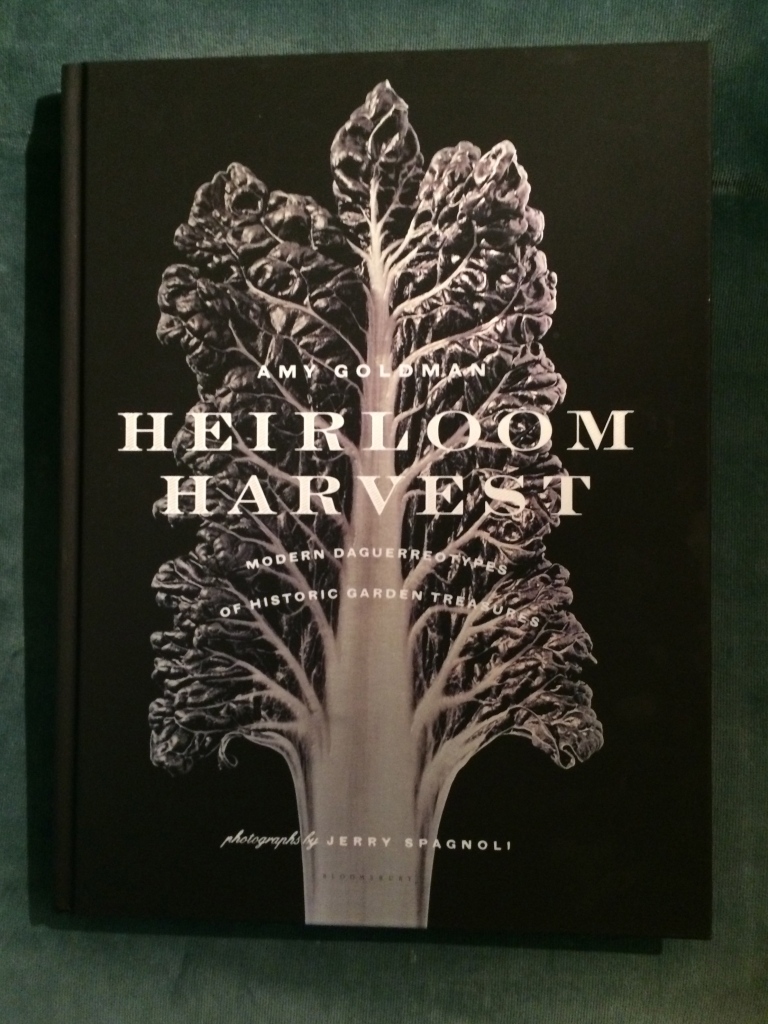
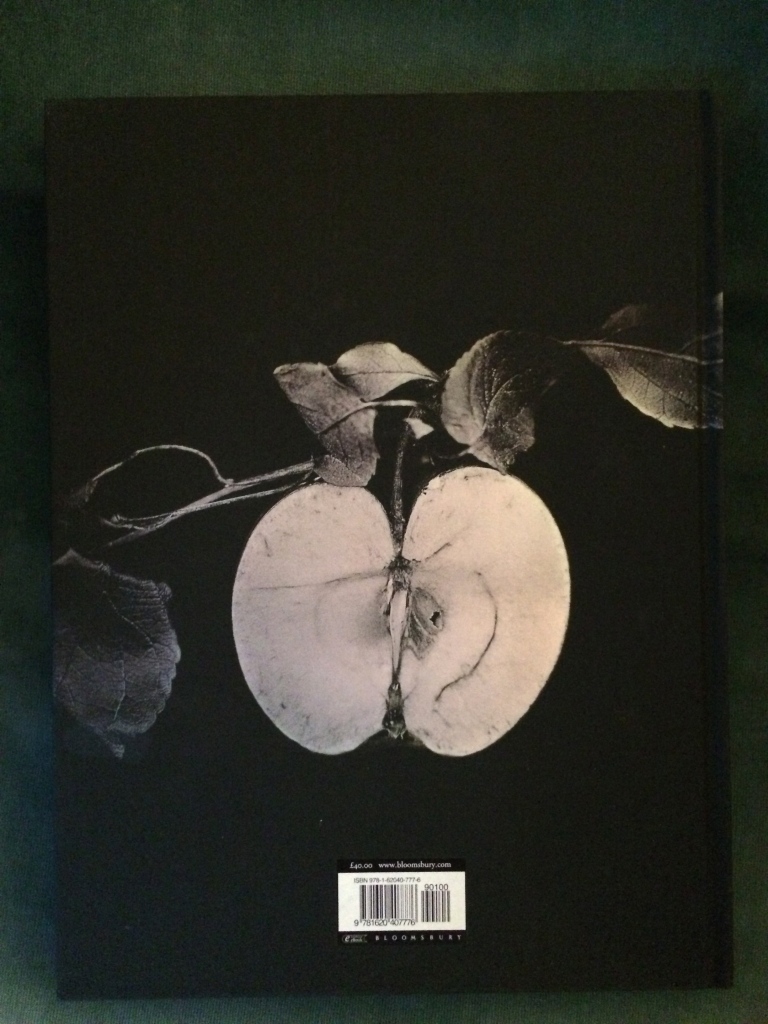 The sumptuous front and back covers of ‘Heirloom Harvest’ by Amy Goldman
The sumptuous front and back covers of ‘Heirloom Harvest’ by Amy Goldman
For me, whereas France and all things French have been woven in and out of my life for decades, the world of American fruit and vegetables is tantalisingly exotic. When Amy writes of serving up ‘homegrown specialities from “the old country” like Tennessee Red peanuts, Southern Giant curly mustard greens, Clemson Spineless okra and Beauregard sweet potatoes’ I am transported to her beautiful 1788 white clapboard farmhouse in the Hudson Valley, New York and I begin to see, smell and taste her life starting with the produce from the soil around the house.
And what a productive life. Amy Goldman has been gardening seriously since she was eighteen, has already written three award winning, personal and intensively knowledgeable books, ‘The Heirloom Tomato’,’ The Compleat Squash’ and ‘Melons for Passionate Growers’, and is a dynamic and influential advocate for heirloom fruits and vegetables and the importance of protecting genetic diversity.
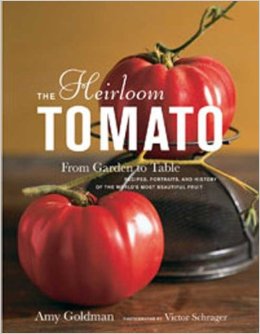
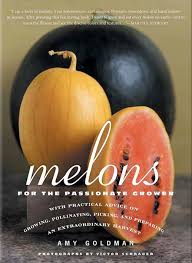 ‘Heirloom Harvest’ is gripping because it is the story of one person’s life and the garden they have made and how one stage of the journey lead to another. She is clear that two key books changed the course of her life. Rosalind Creasy’s ‘Cooking from the Garden’ which ‘opened my eyes to the splendour and diversity of heirlooms, their uses in cookery and edible landscaping’ and Cary Fowler and Pat Mooney’s ‘Shattering: Food, Politics and the Loss of Genetic Diversity’ which ‘alerted me to the dangers of crop uniformity and the staggering and mounting losses of genetic diversity in agriculture’. If Paris is the ‘City of Love’, it fits well with this post that Amy ended up falling in love with and marrying Cary, and they now live and farm together, always trying to grow and protect new varieties of fruits, vegetables and now rare breeds of animal too, and storing seeds in their basement refrigerator seed bank.
‘Heirloom Harvest’ is gripping because it is the story of one person’s life and the garden they have made and how one stage of the journey lead to another. She is clear that two key books changed the course of her life. Rosalind Creasy’s ‘Cooking from the Garden’ which ‘opened my eyes to the splendour and diversity of heirlooms, their uses in cookery and edible landscaping’ and Cary Fowler and Pat Mooney’s ‘Shattering: Food, Politics and the Loss of Genetic Diversity’ which ‘alerted me to the dangers of crop uniformity and the staggering and mounting losses of genetic diversity in agriculture’. If Paris is the ‘City of Love’, it fits well with this post that Amy ended up falling in love with and marrying Cary, and they now live and farm together, always trying to grow and protect new varieties of fruits, vegetables and now rare breeds of animal too, and storing seeds in their basement refrigerator seed bank.
Equally compelling are the book’s startlingly rich daguerreotype photographs by Jerry Spagnoli. I try to work out what it is about the images that is so fascinating. There is an inviting, shimmering softness to many of the photographs but perhaps it is the depth of tone – one critic describes it brilliantly as ‘an austere sepia’ – which surprises me into looking more closely. The technique is wonderful for capturing the roughness of earth-caked vegetables or for the almost gritty surface of the ‘Tyson Pear’ and there is a wonderful, clear, light-catching quality to photographs such as ‘White Currants’:
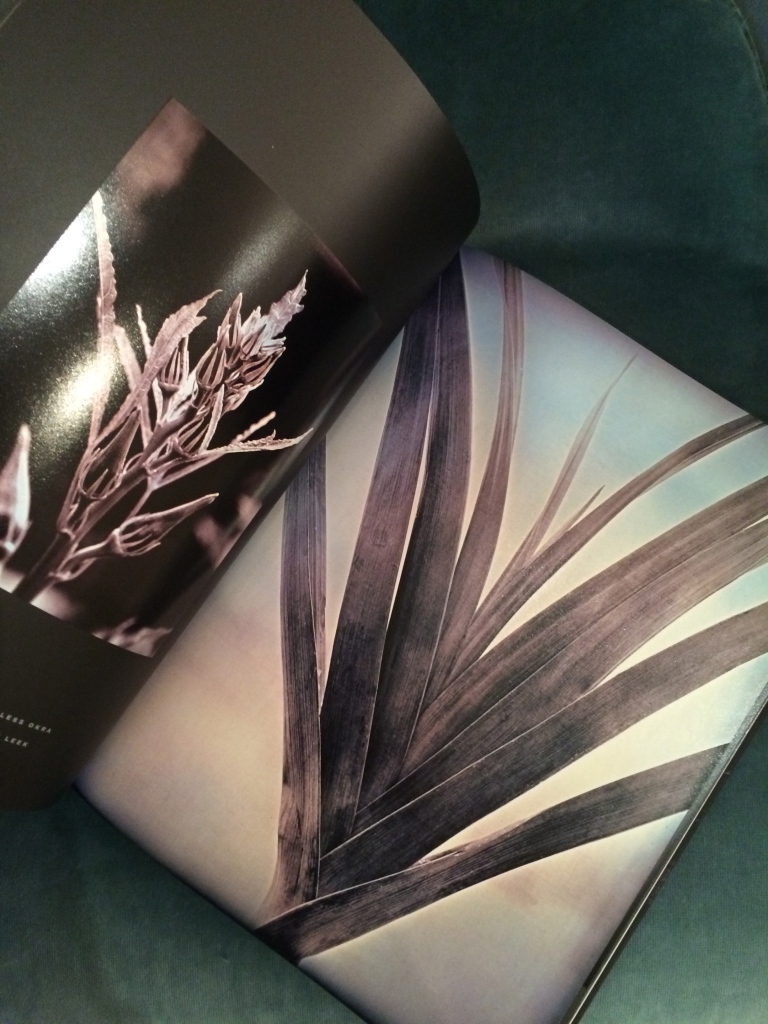 ‘American Flag Leek’ by Jerry Spagnoli from ‘Heirloom Harvest’ by Amy Goldman
‘American Flag Leek’ by Jerry Spagnoli from ‘Heirloom Harvest’ by Amy Goldman
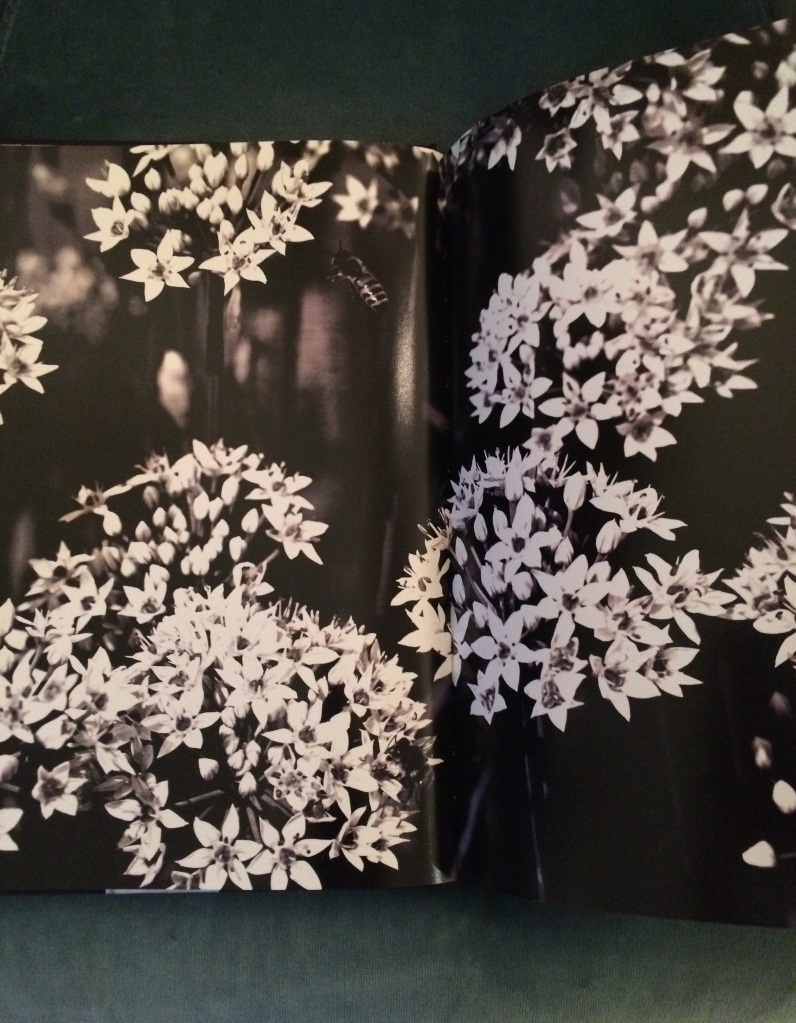 ‘Garlic Chives’ by Jerry Spagnoli from ‘Heirloom Harvest’ by Amy Goldman
‘Garlic Chives’ by Jerry Spagnoli from ‘Heirloom Harvest’ by Amy Goldman
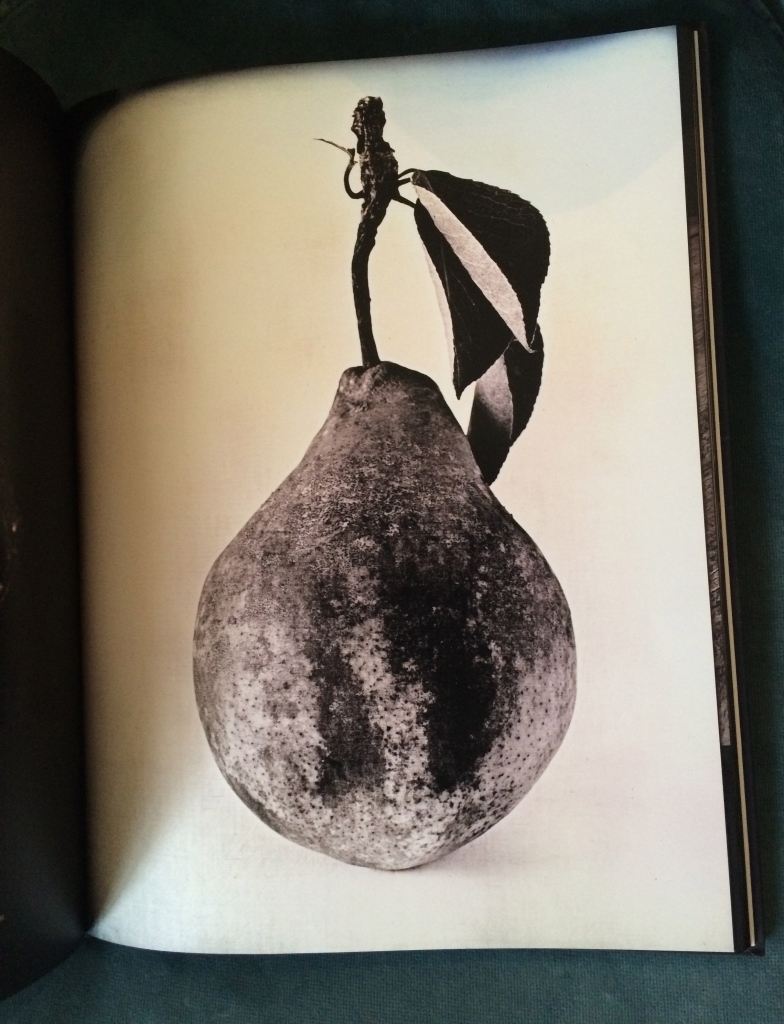 ‘Tyson Pear’, photograph by Jerry Spagnoli from ‘Heirloom Harvest’ by Amy Goldman
‘Tyson Pear’, photograph by Jerry Spagnoli from ‘Heirloom Harvest’ by Amy Goldman
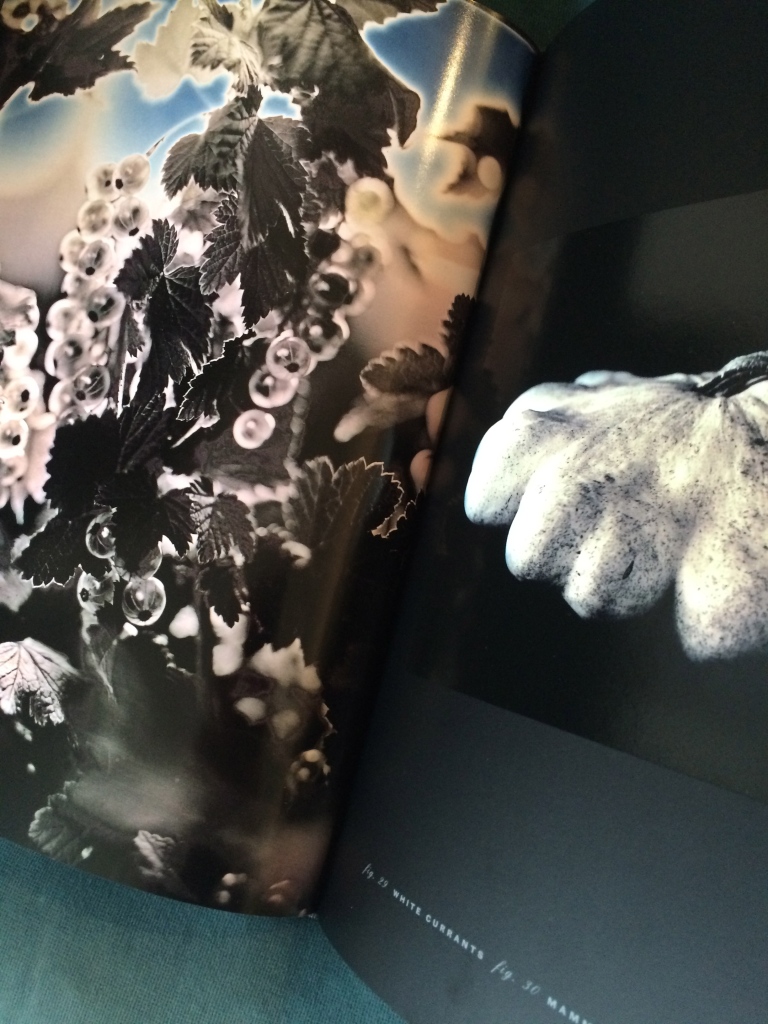 ‘White Currants’ by Jerry Spagnoli from ‘Heirloom Harvest’ by Amy Goldman
‘White Currants’ by Jerry Spagnoli from ‘Heirloom Harvest’ by Amy Goldman
I remind myself what the daguerreotype process entails. There is a sobering You Tube film by Anthony Mournian of Jerry Spagnoli demonstrating the basic principles. It is a complex, hard graft, photographic technique invented in 1839 that produces images on highly polished, silver clad copper plates. Jerry Spagnoli collaborated with Amy Goldman for a period of 14 years on the photographs for the book. His depth of commitment and constant, inventive resourcefulness in producing these beautiful, time-suspended images is inspiring.
In Paris we are staying in our favourite, relaxed Le Citizen Hotel (not to be confused with the Citizen M hotel chain!) in the Canal St Martin area. We love the easy friendliness of the hotel, the quirky breakfast or fragrant cup of tea that they will make for you at any time. It is our last day and we call in at the small and charismatic flower shop, Bleuet Coquelicot. The charming ‘Tom des Fleurs’ invites us – but what is so uplifting is the way his plants spill out onto the pavement – in front of the cafe next door and beyond.
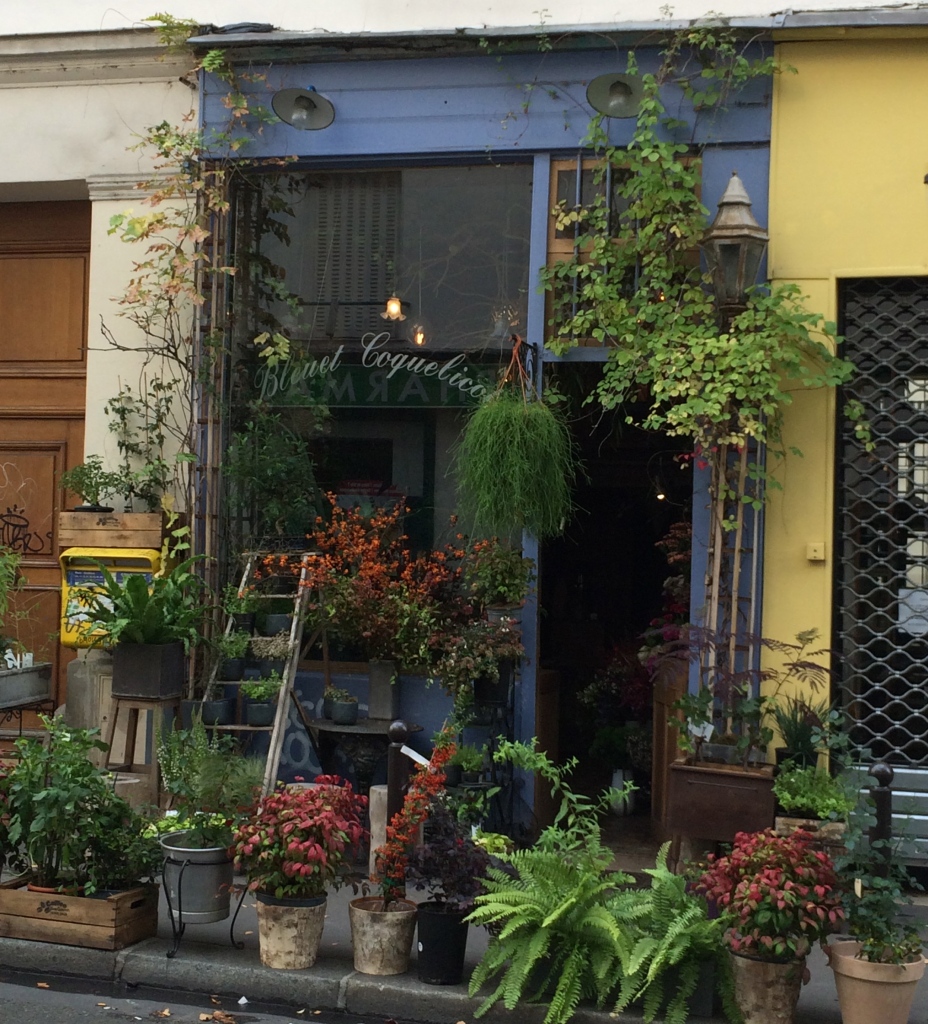
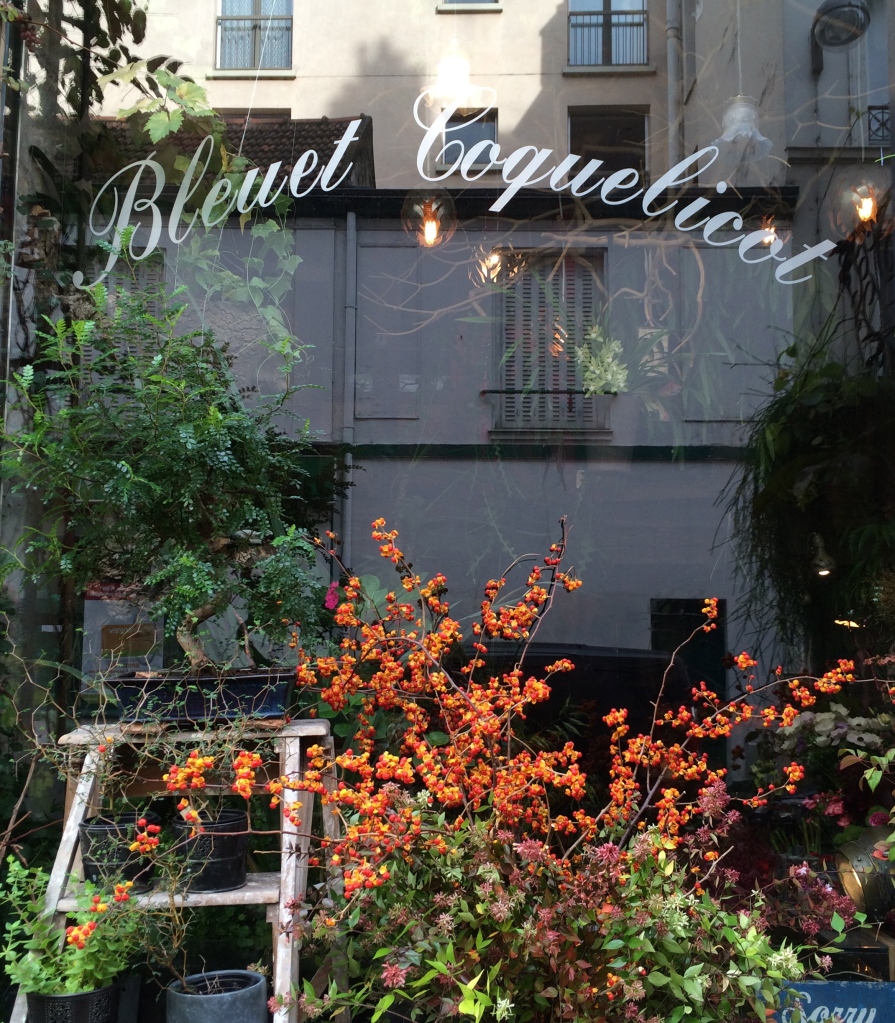
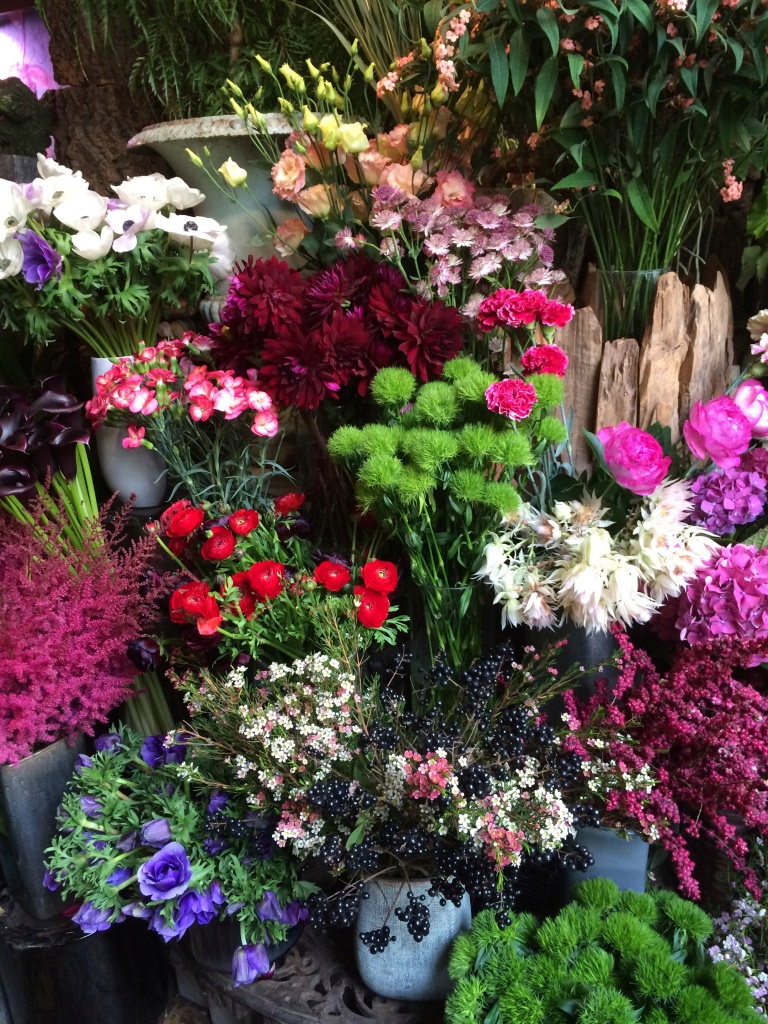
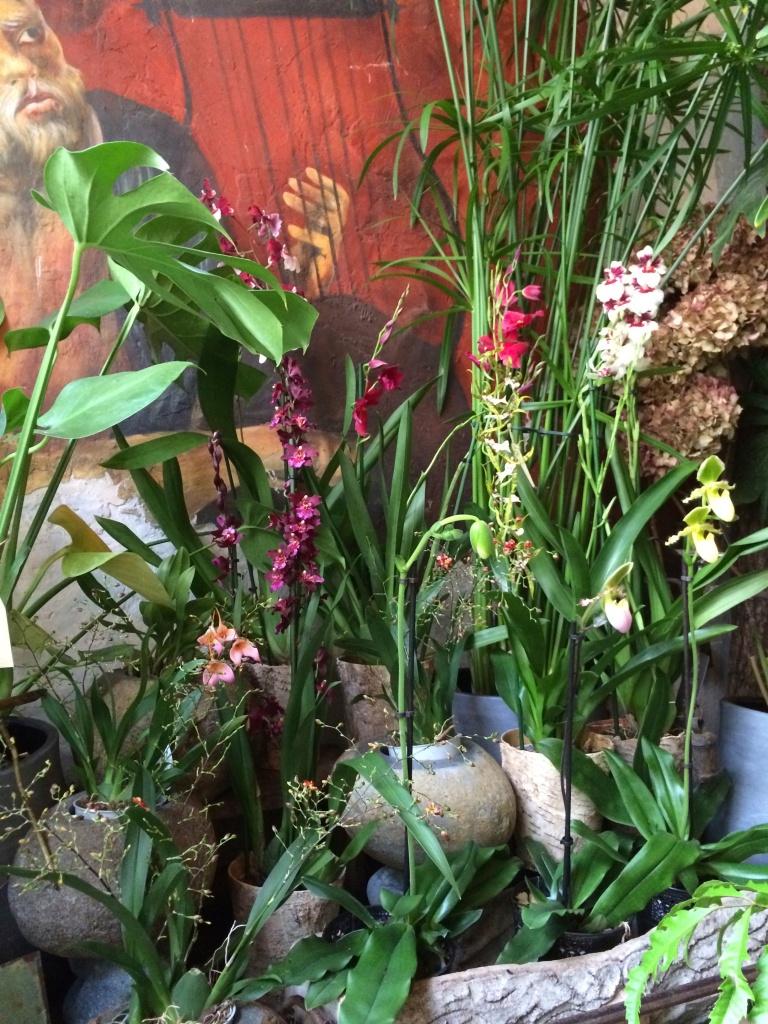 Bleuet Coquelicot, florist, inside and out
Bleuet Coquelicot, florist, inside and out
Bleuet Coquelicot is thoughtful and gentle and unorthodox in its approach to flowers and to life – Tom is well known for only selling plants to people he can trust to look after them properly. If you order flowers from the shop you will be likely to receive what French Vogue has described as ‘more wildflower meadow than curated city bouquet’.
I am hugely saddened to say this is exactly the part of Paris, youthful, vibrant, constantly evolving, with its network of tiny restaurants and experimental shops that was hit so hard on Friday 13th November.
We walk through the Tuileries Garden admiring a pair of ever handsome ‘Luxembourg’ chairs painted in that familiar shade of mid green, now empty at the end of the day. We promise to return to the city in the spring.
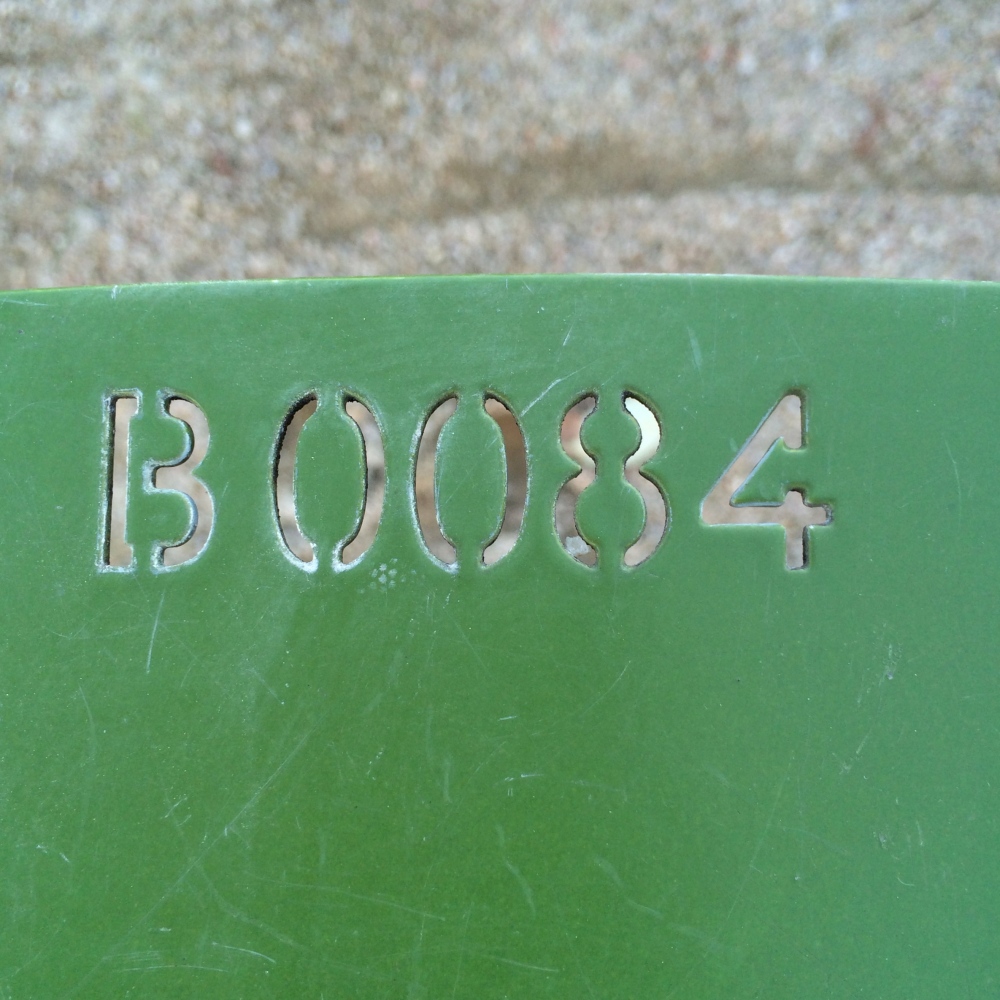
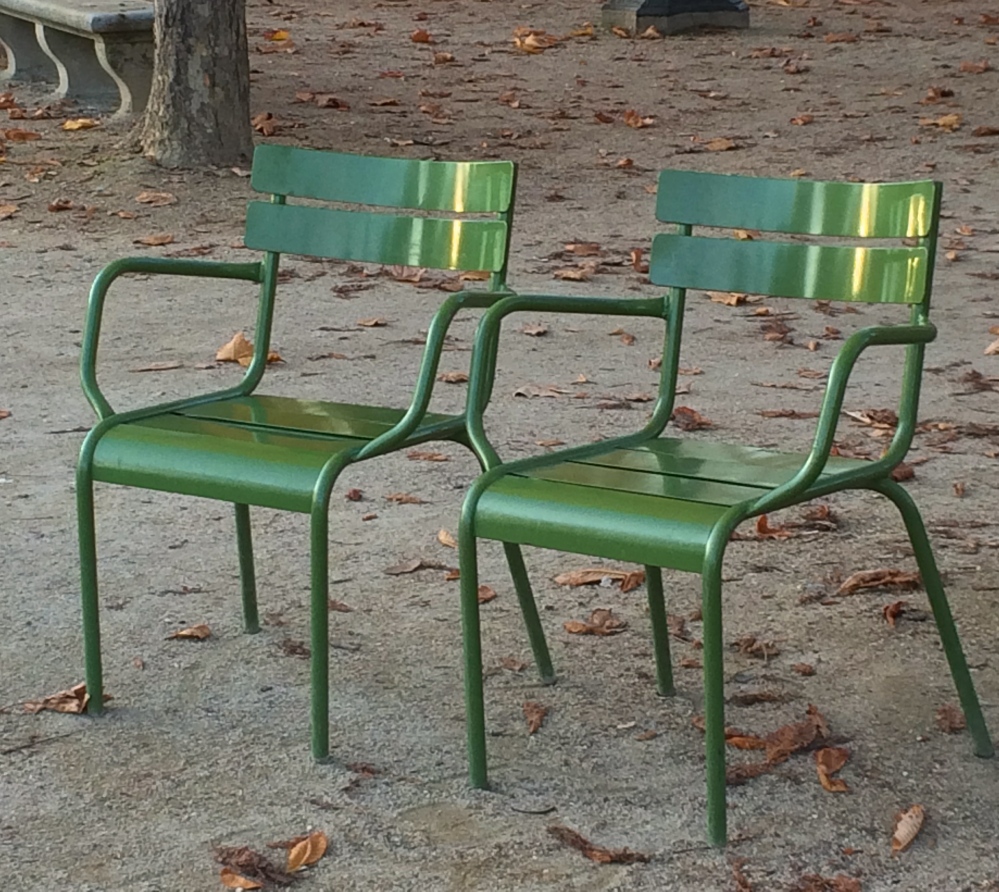 ‘Luxembourg’ chairs, Tuileries Gardens, Paris
‘Luxembourg’ chairs, Tuileries Gardens, Paris
